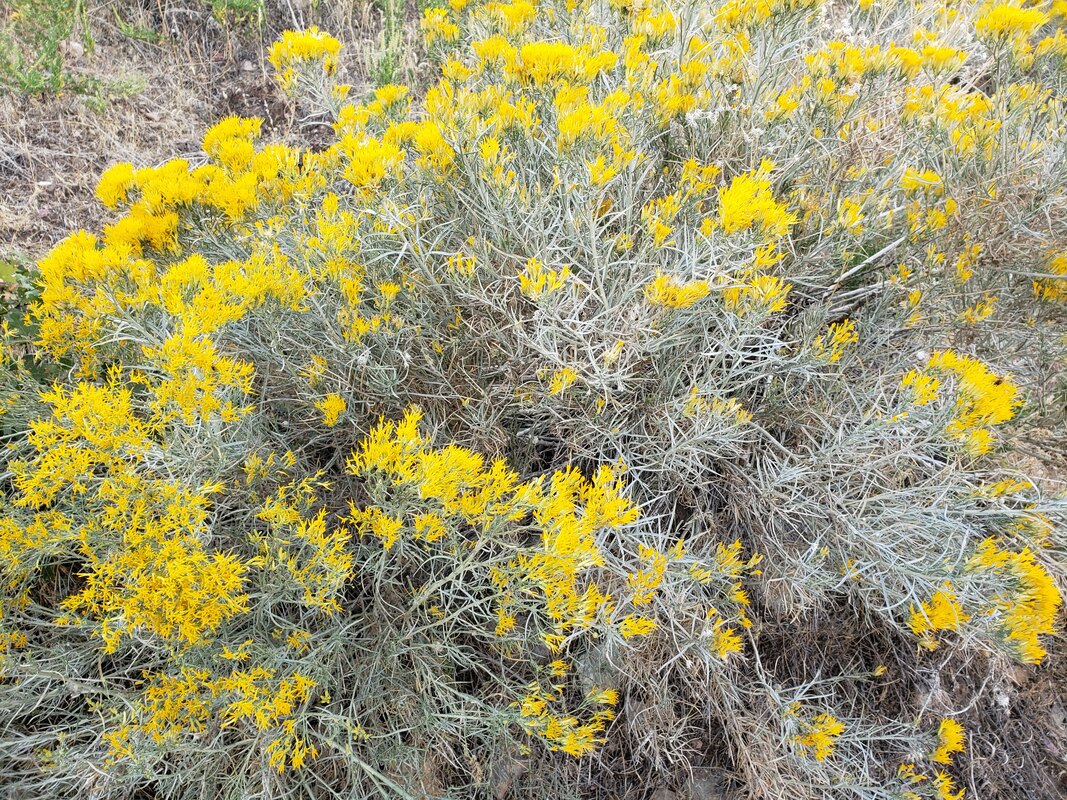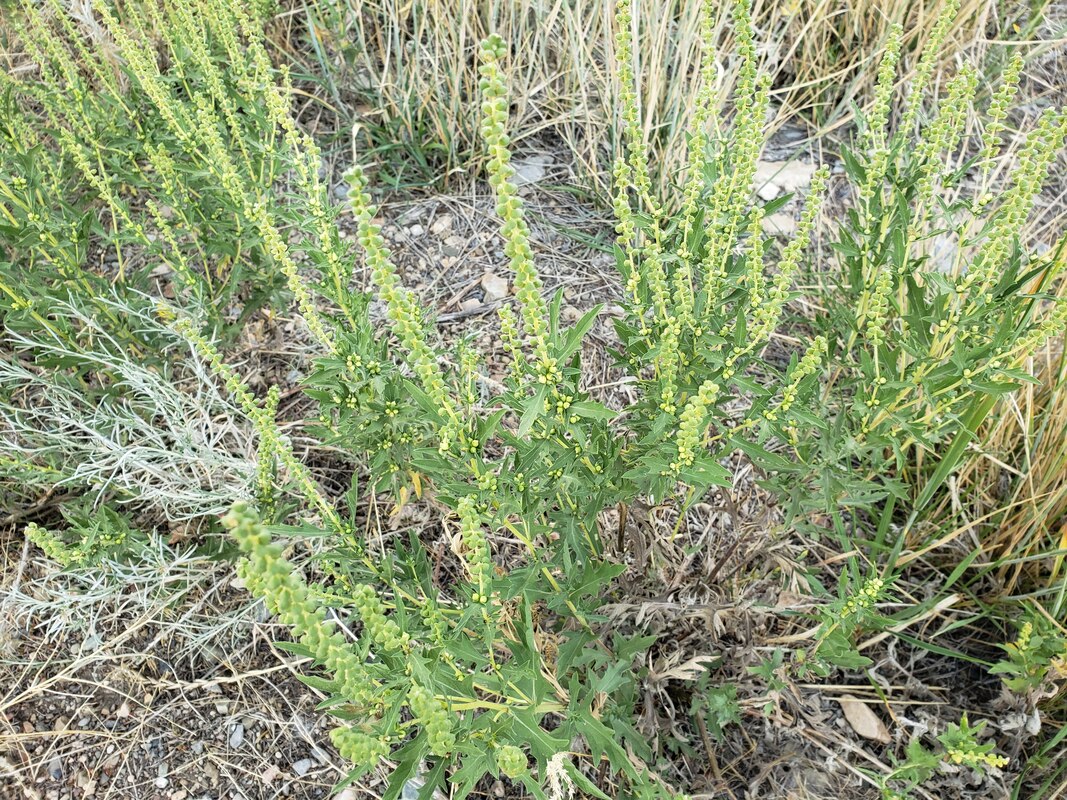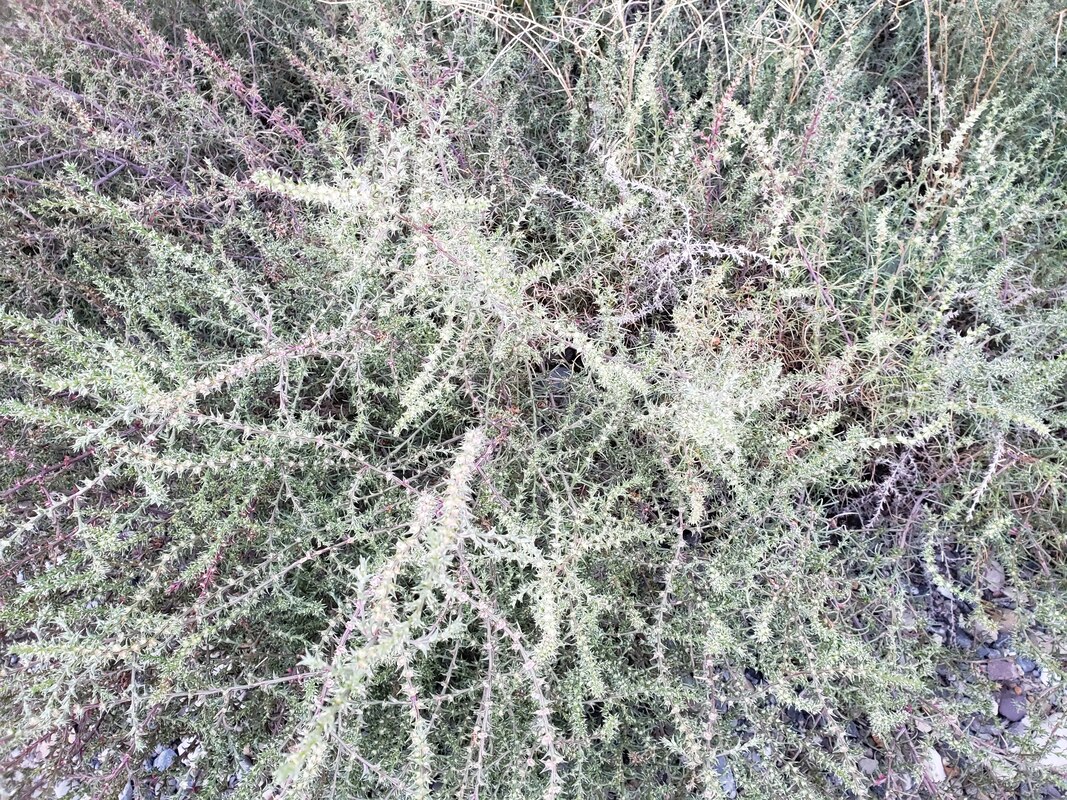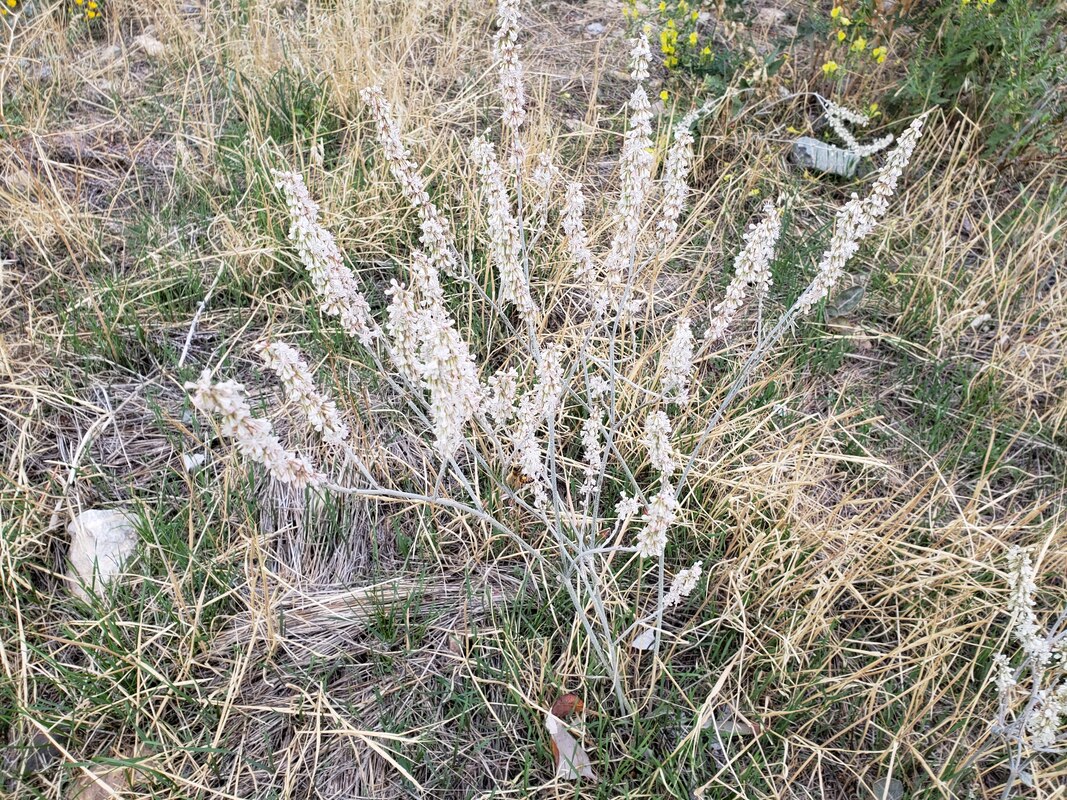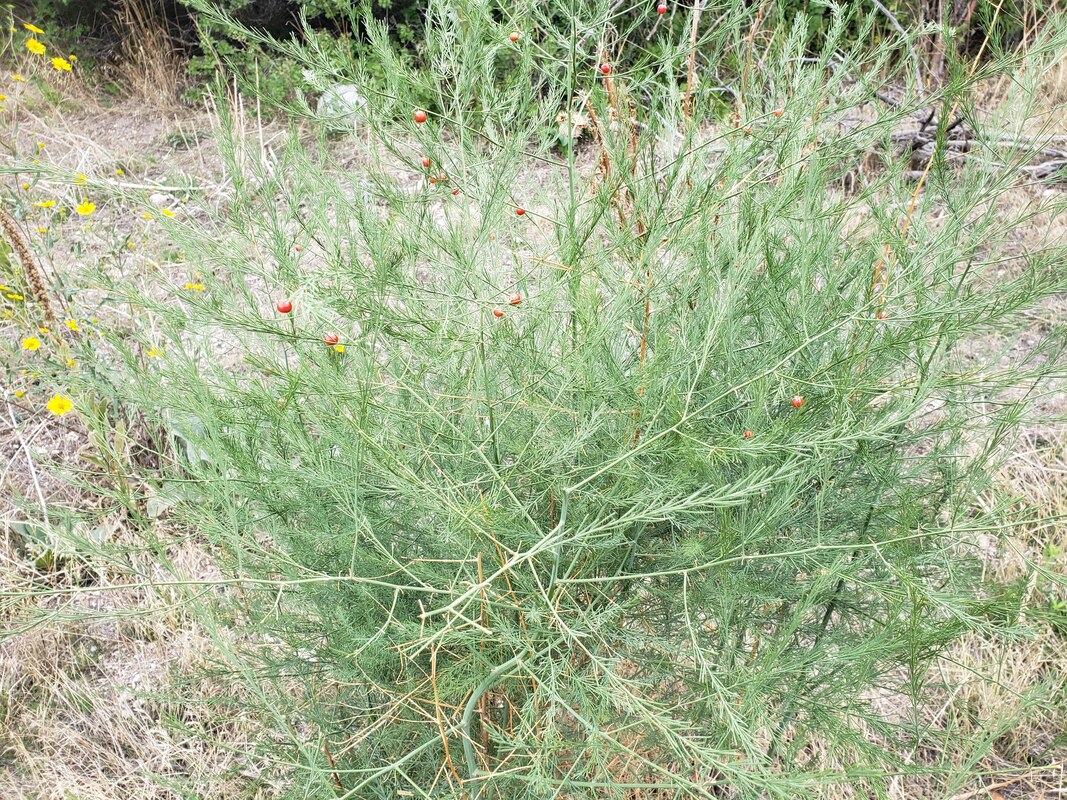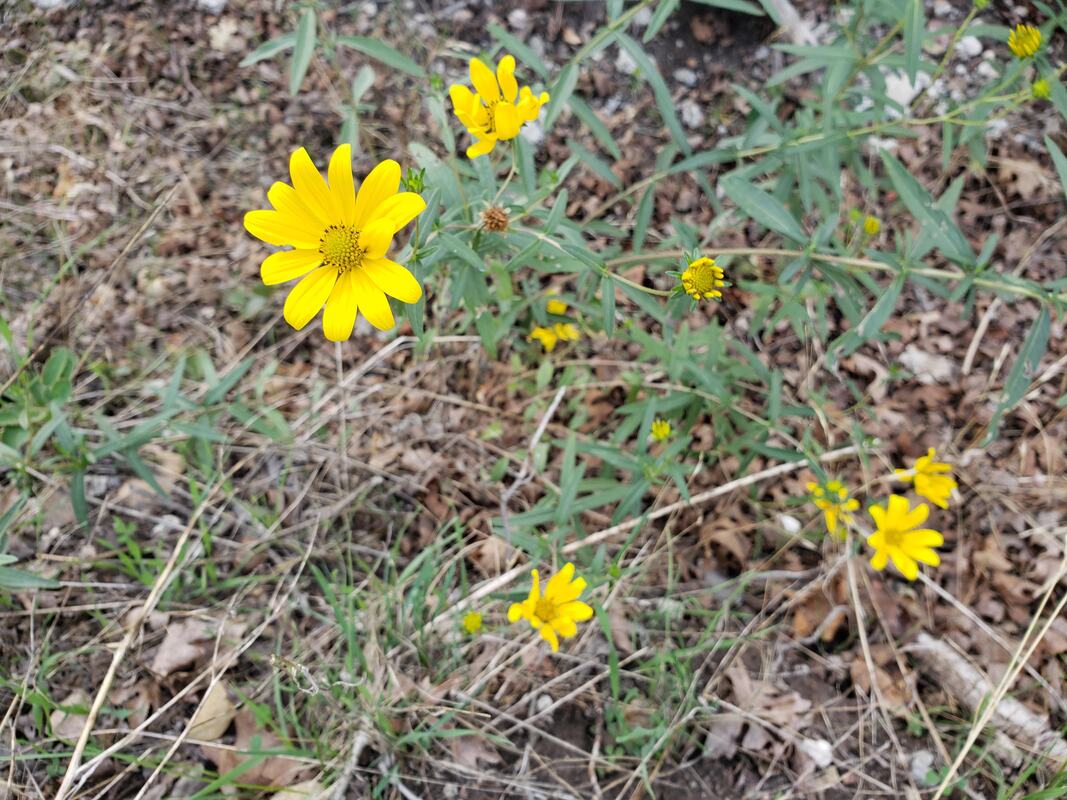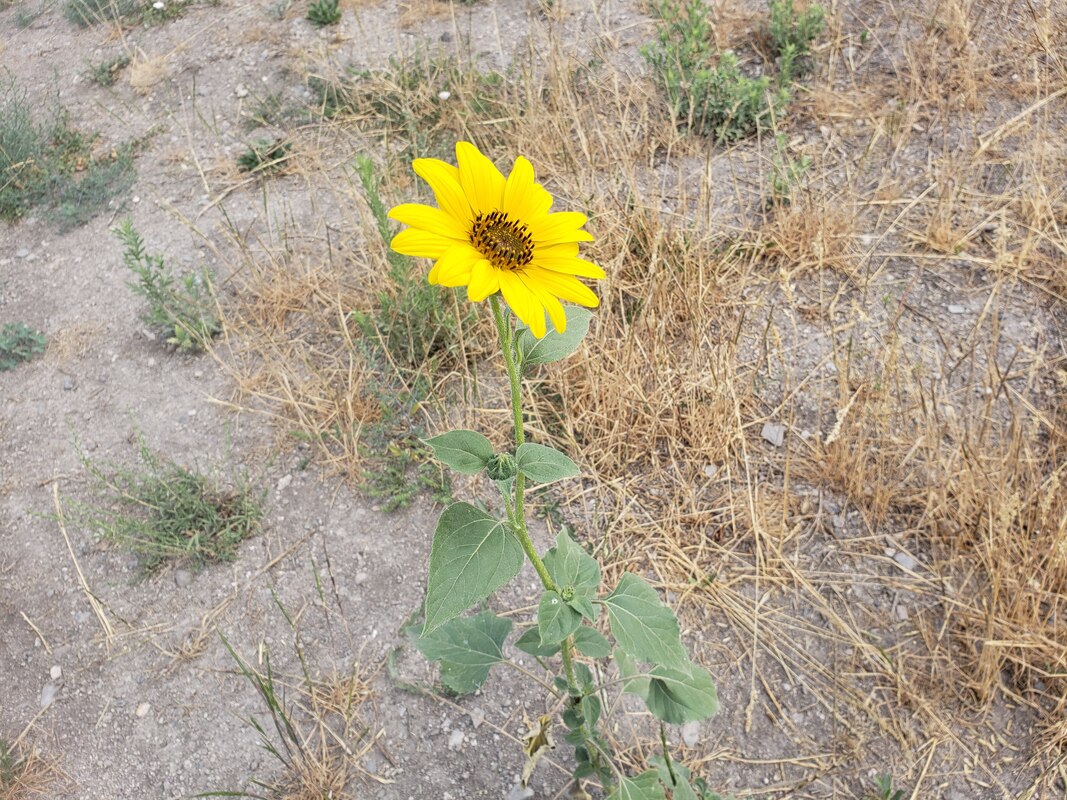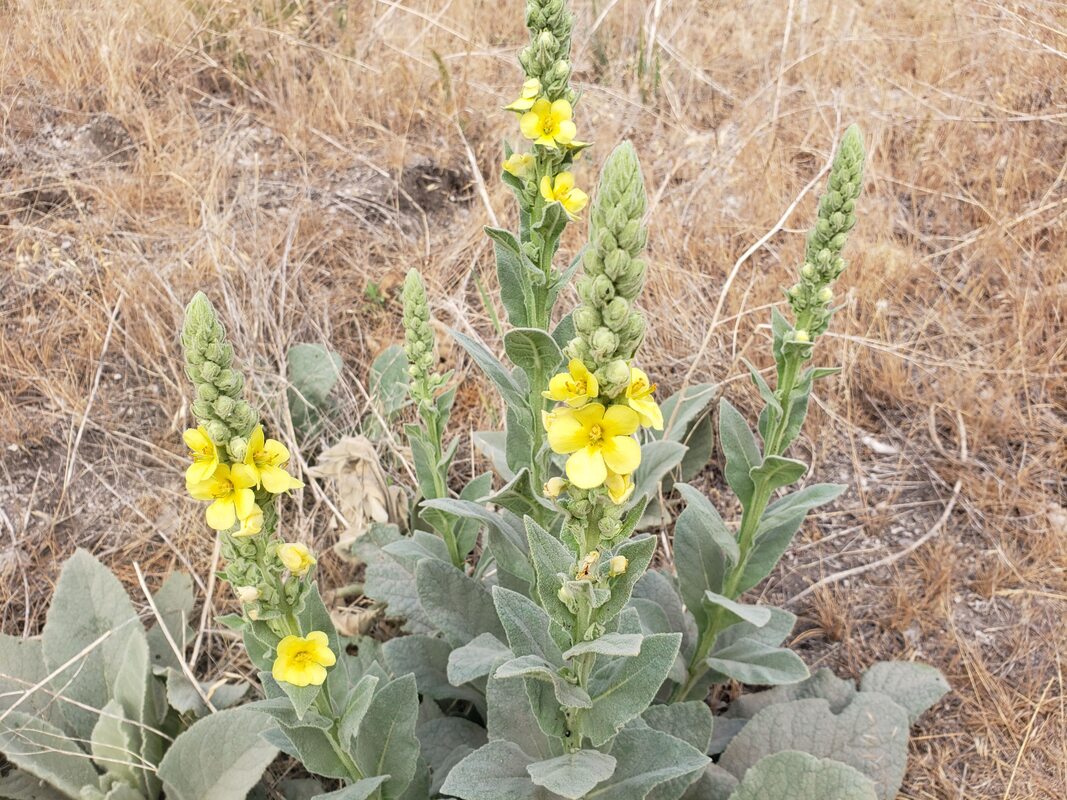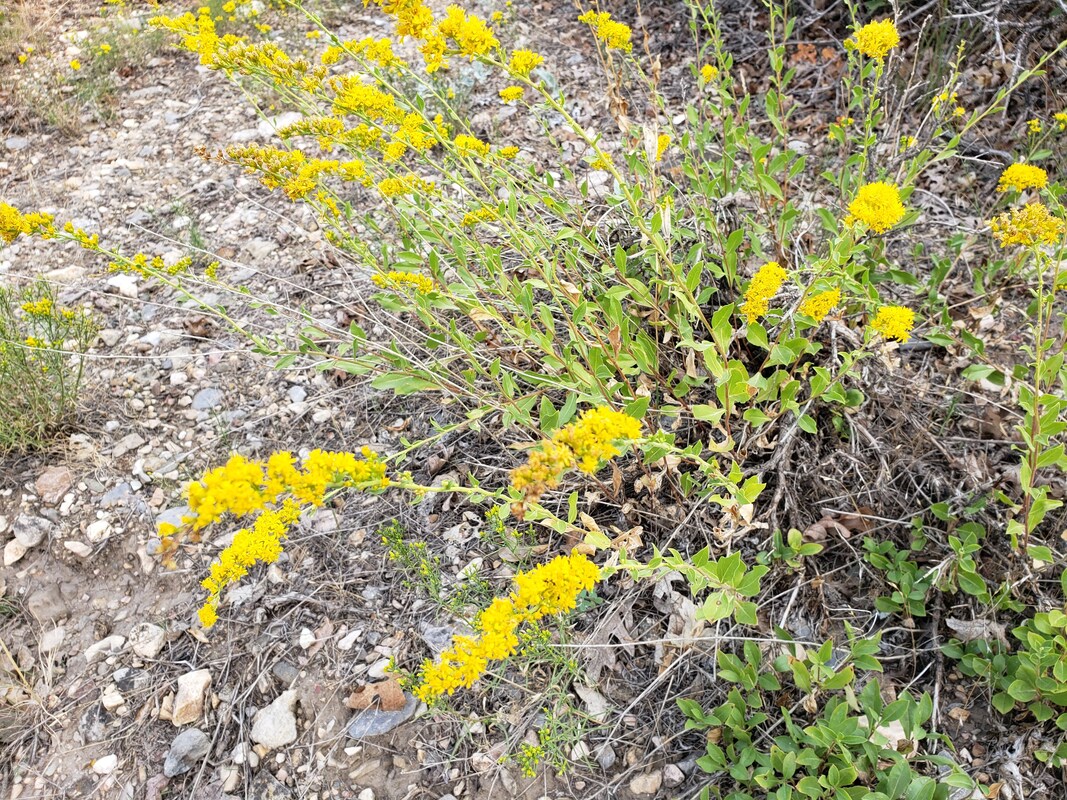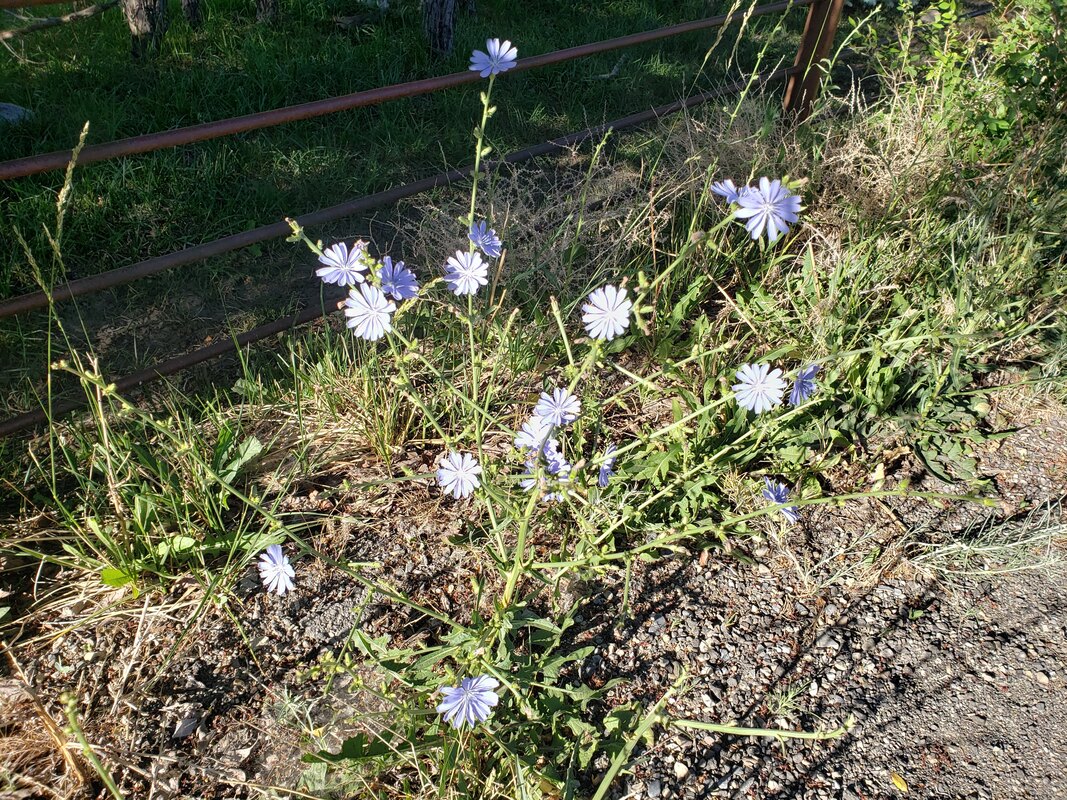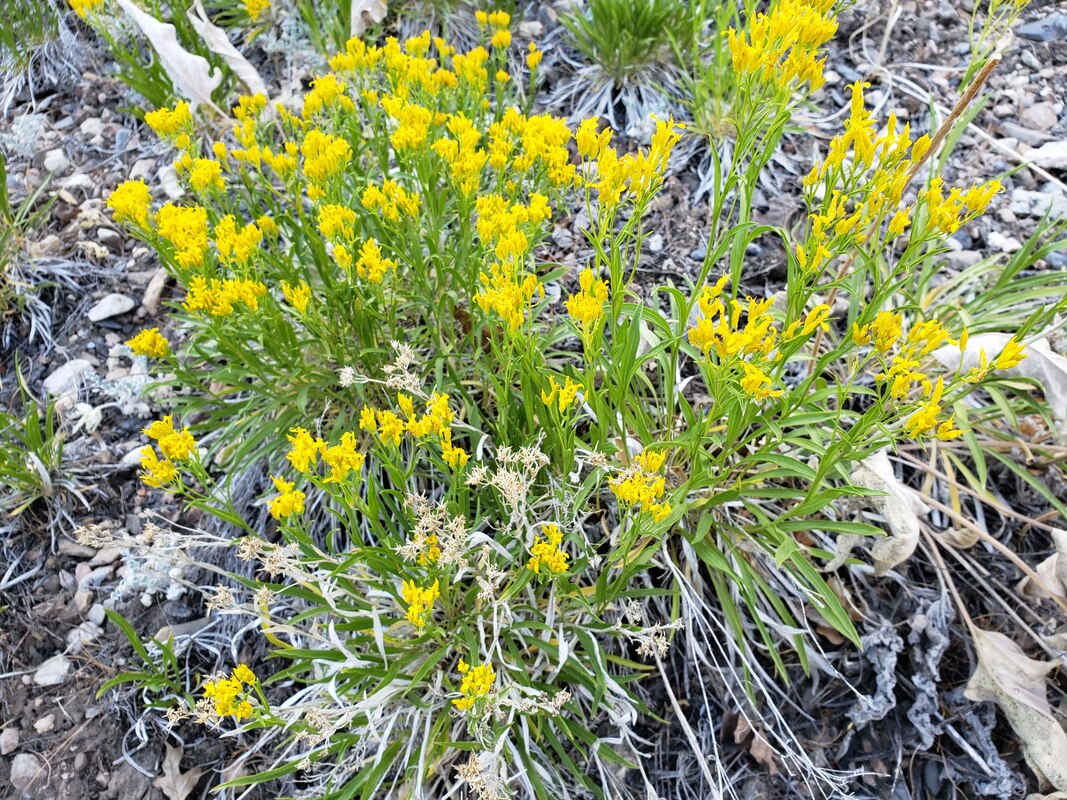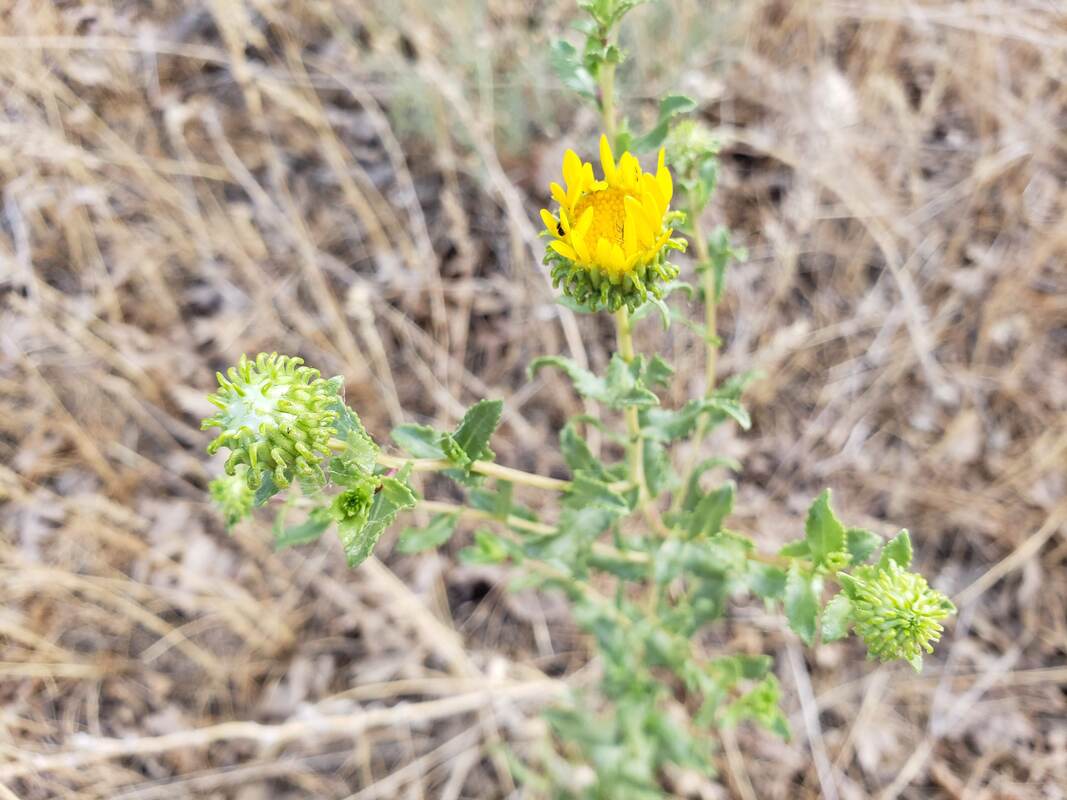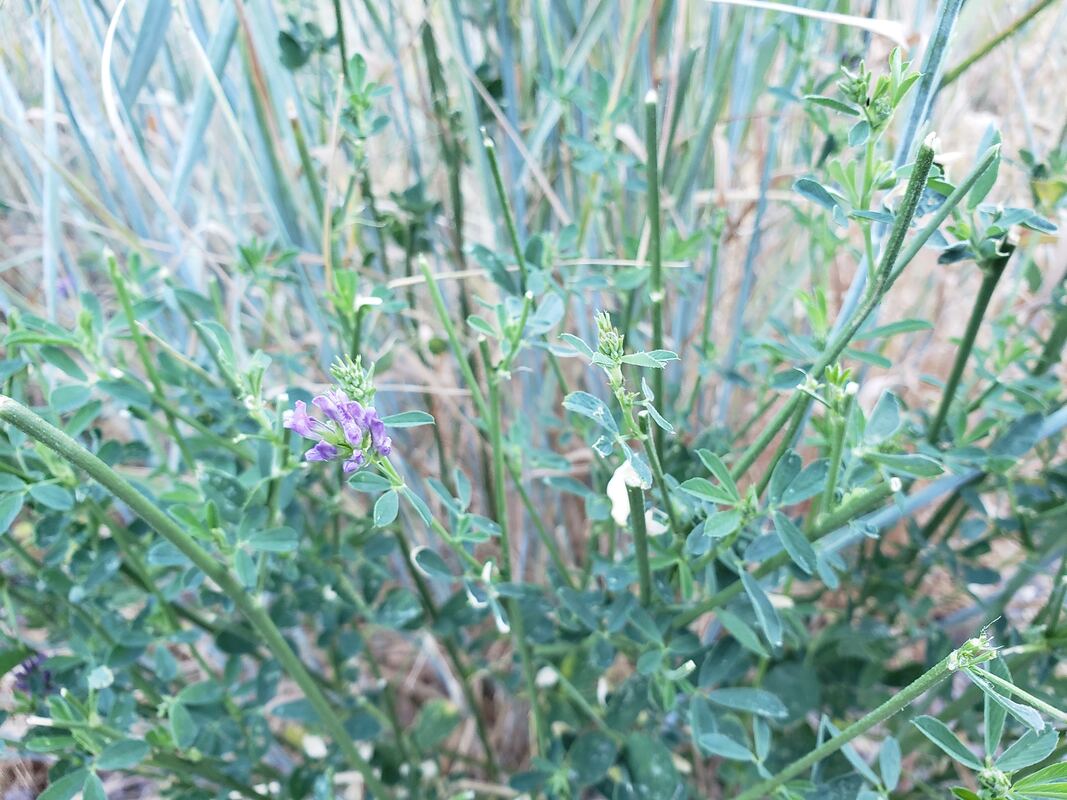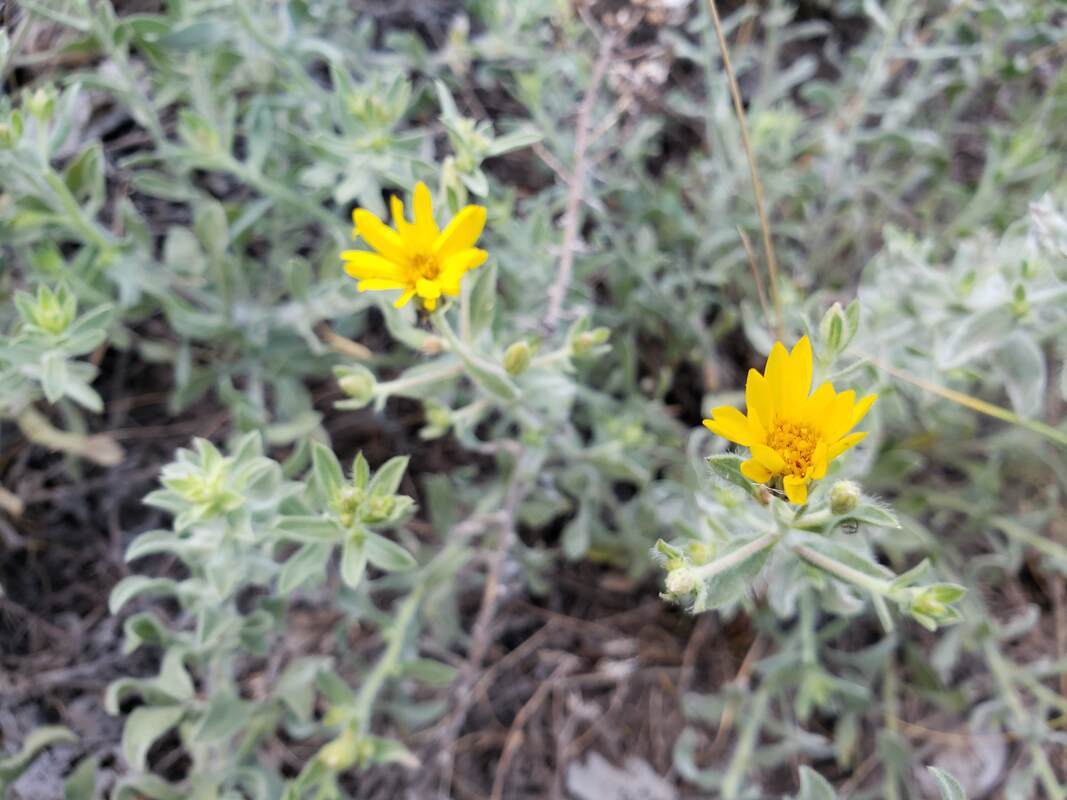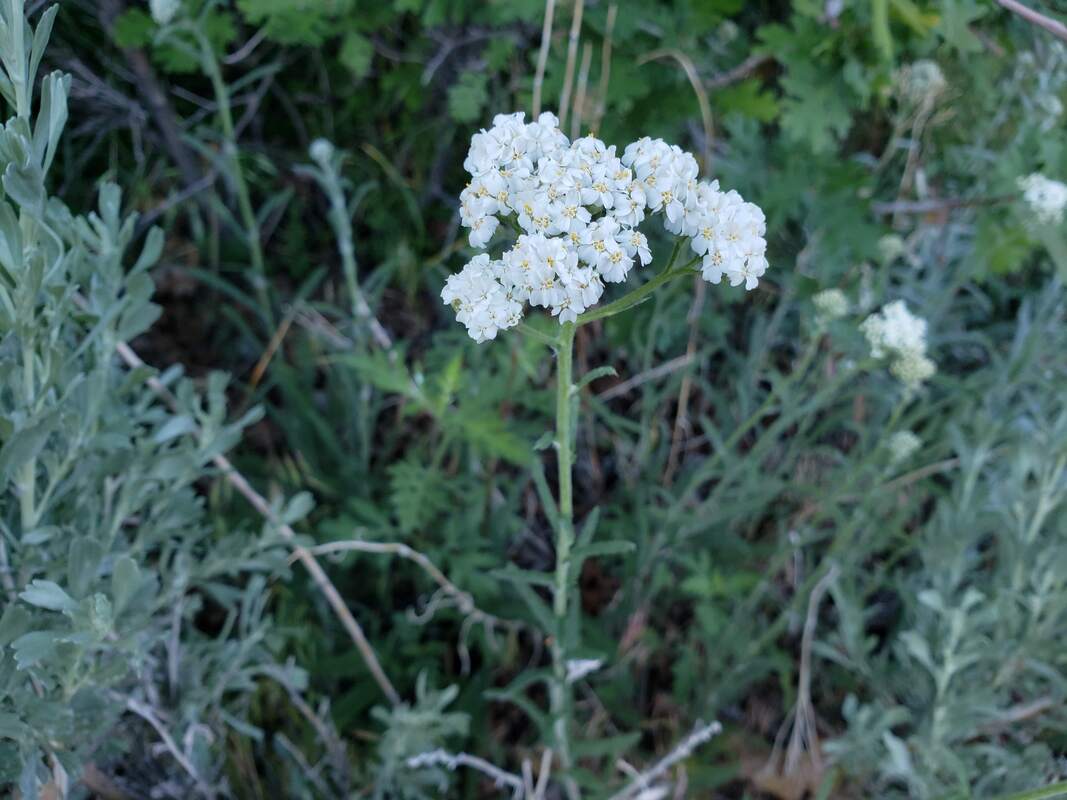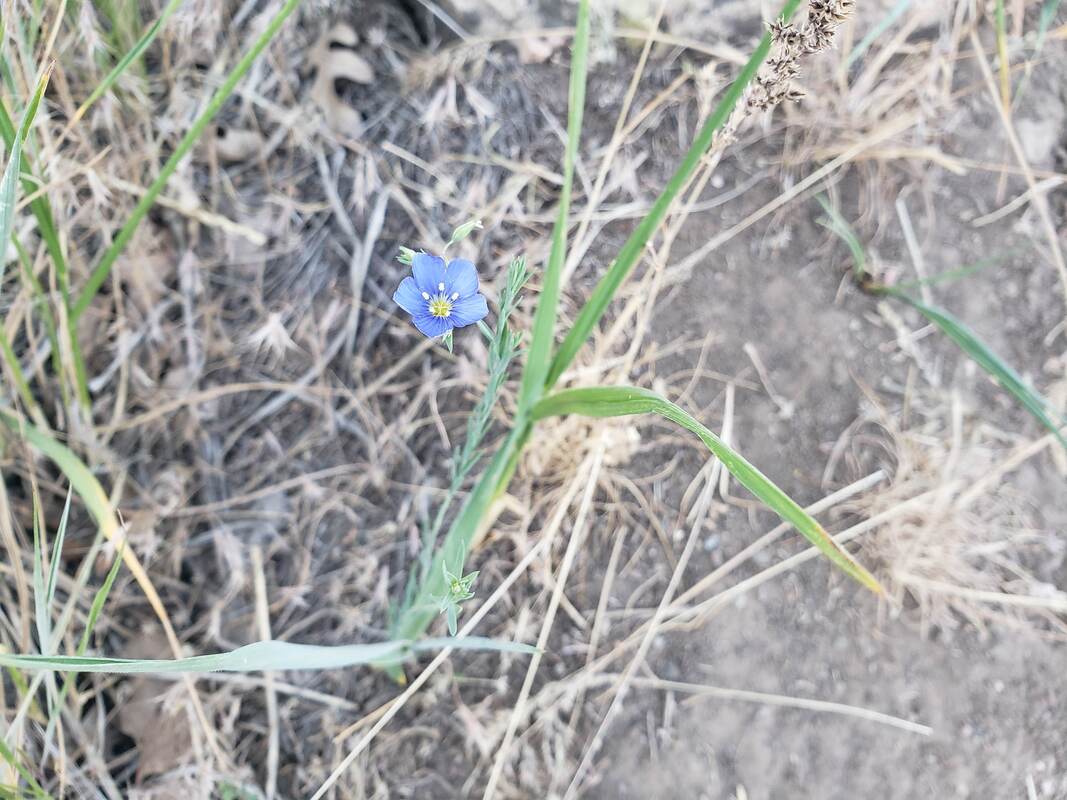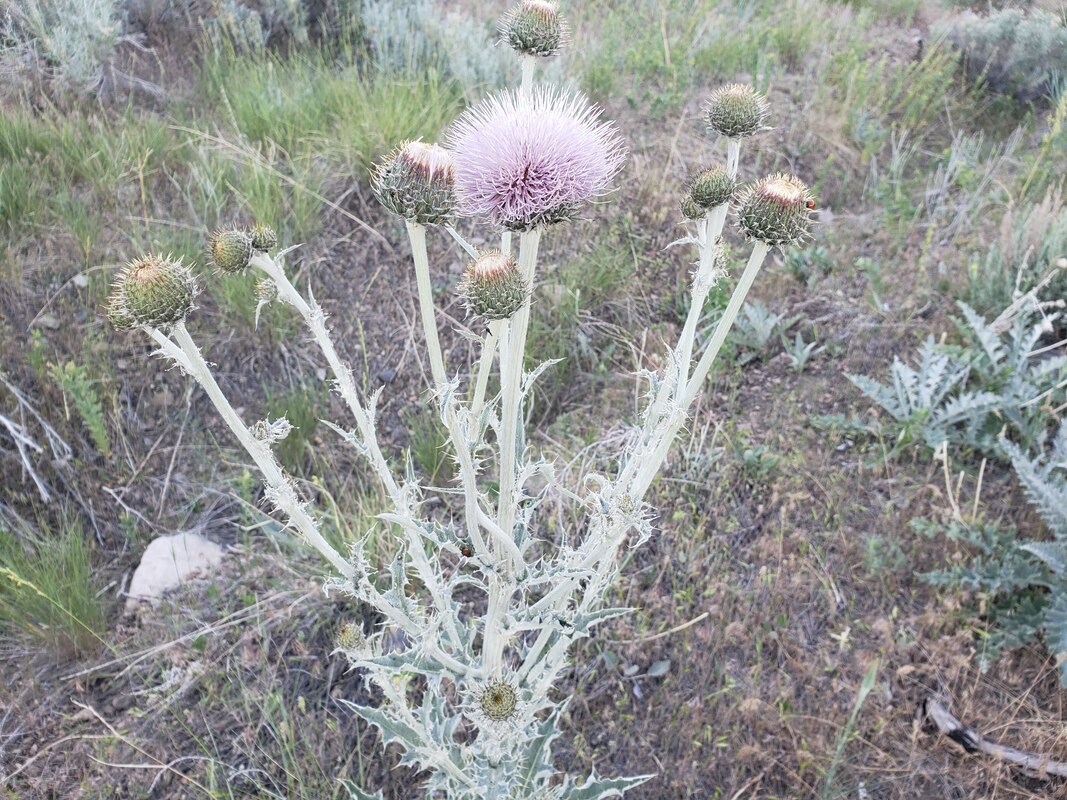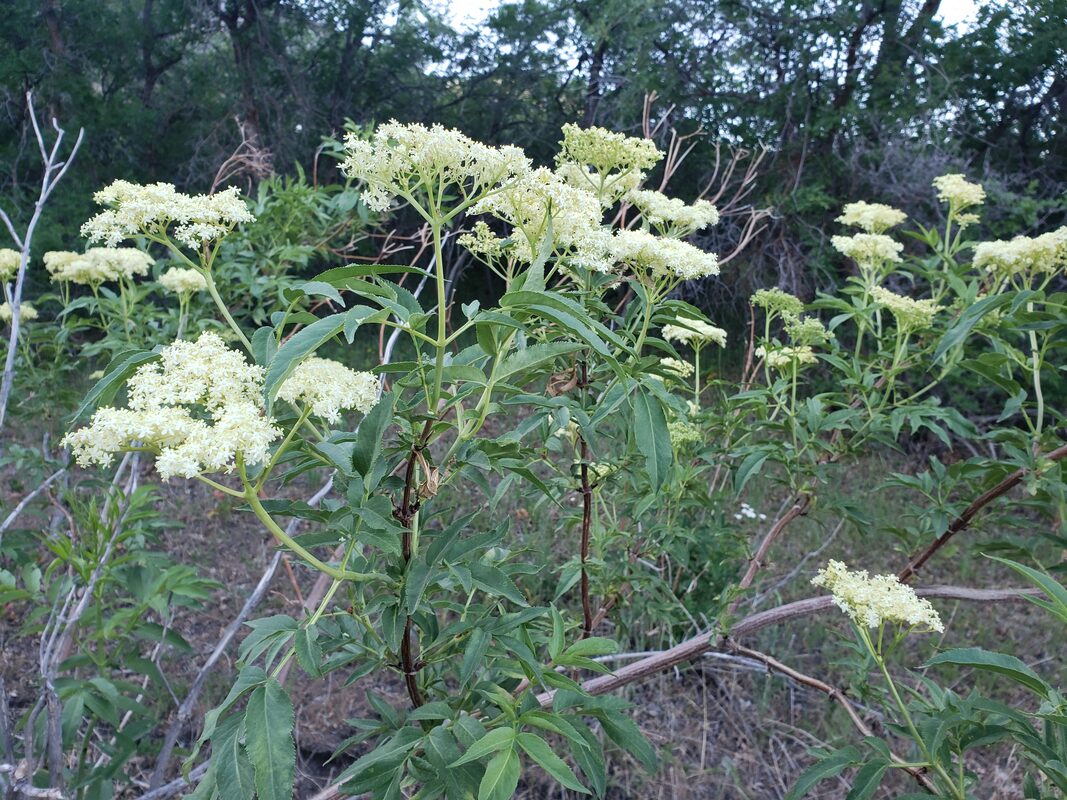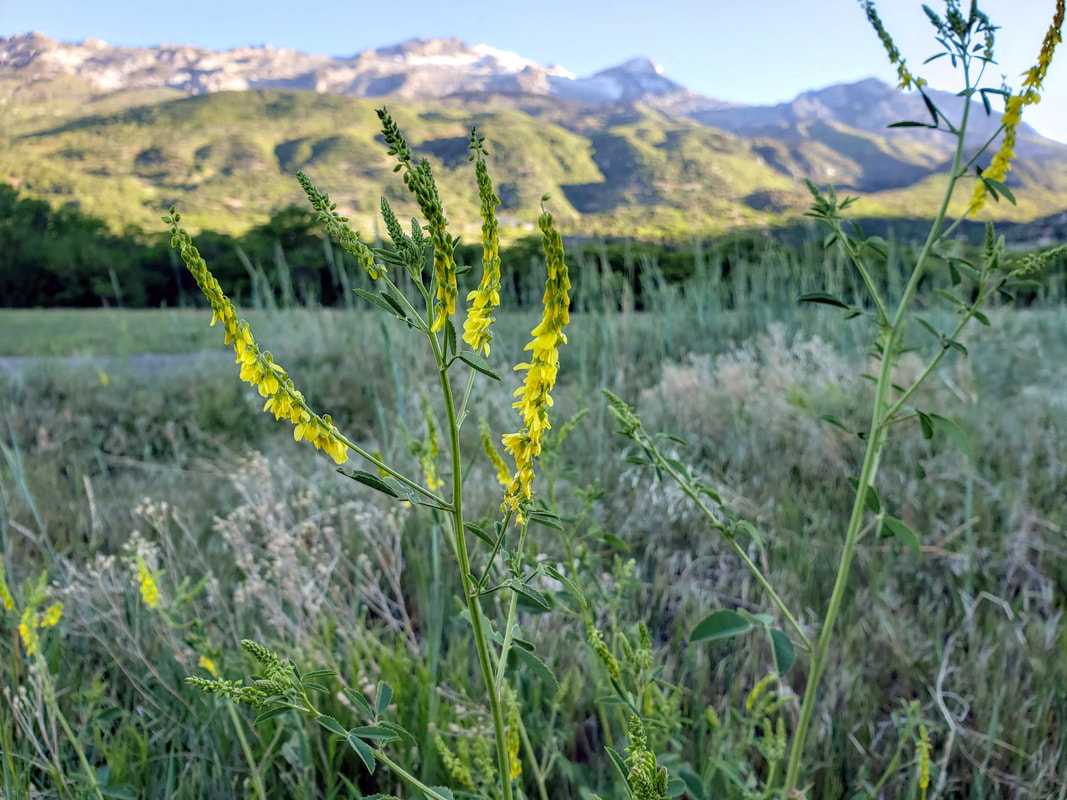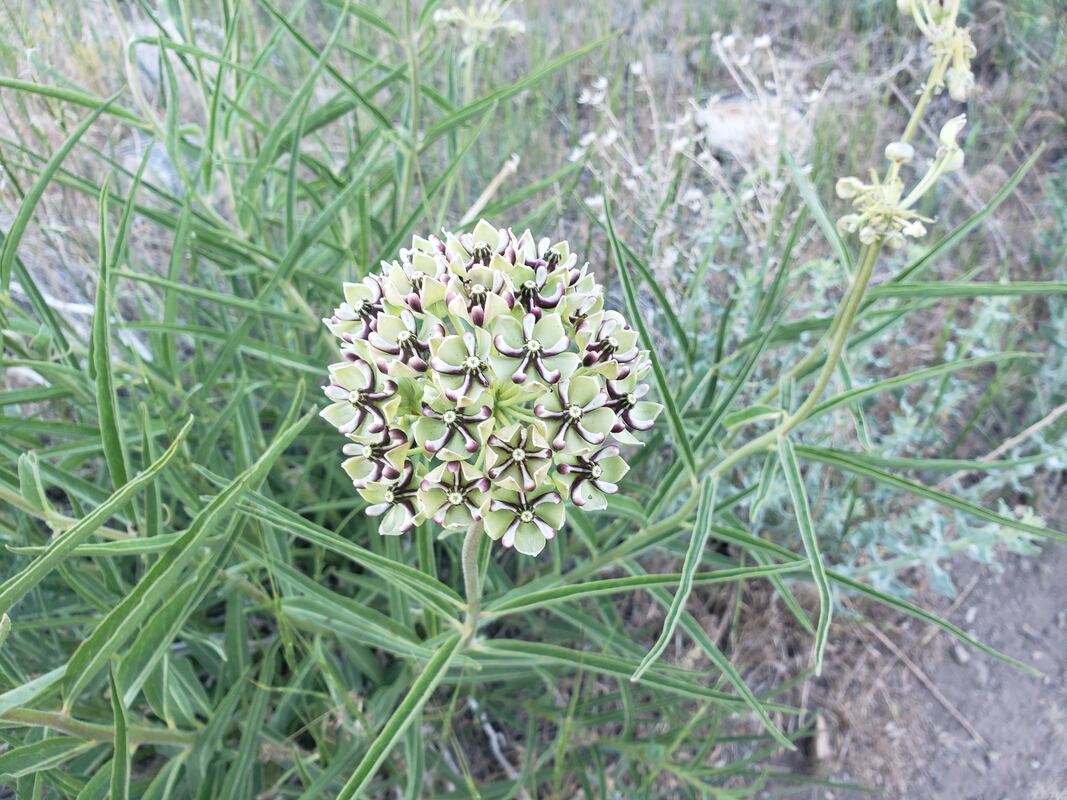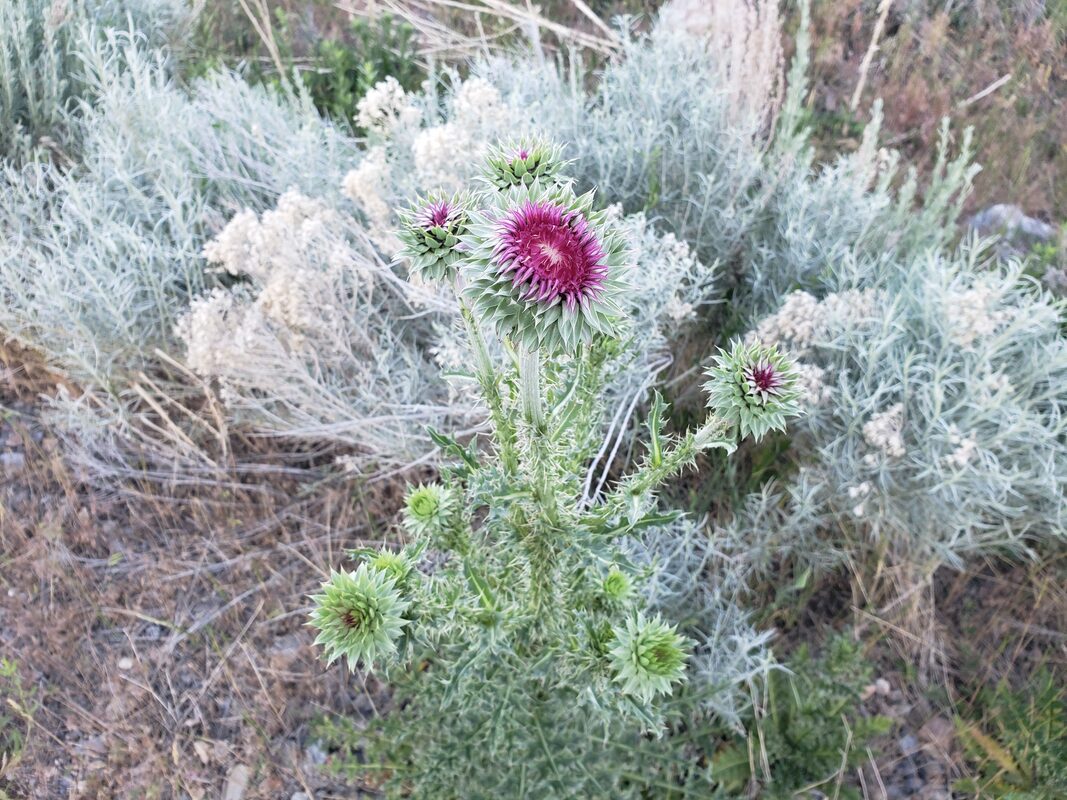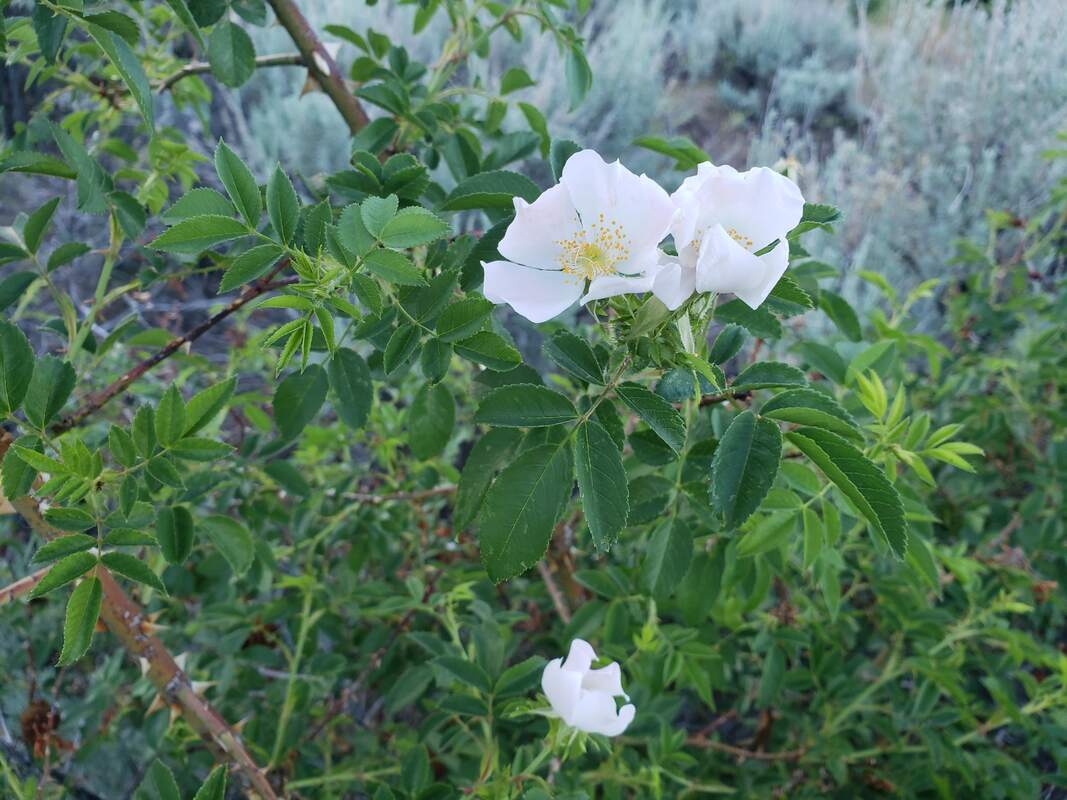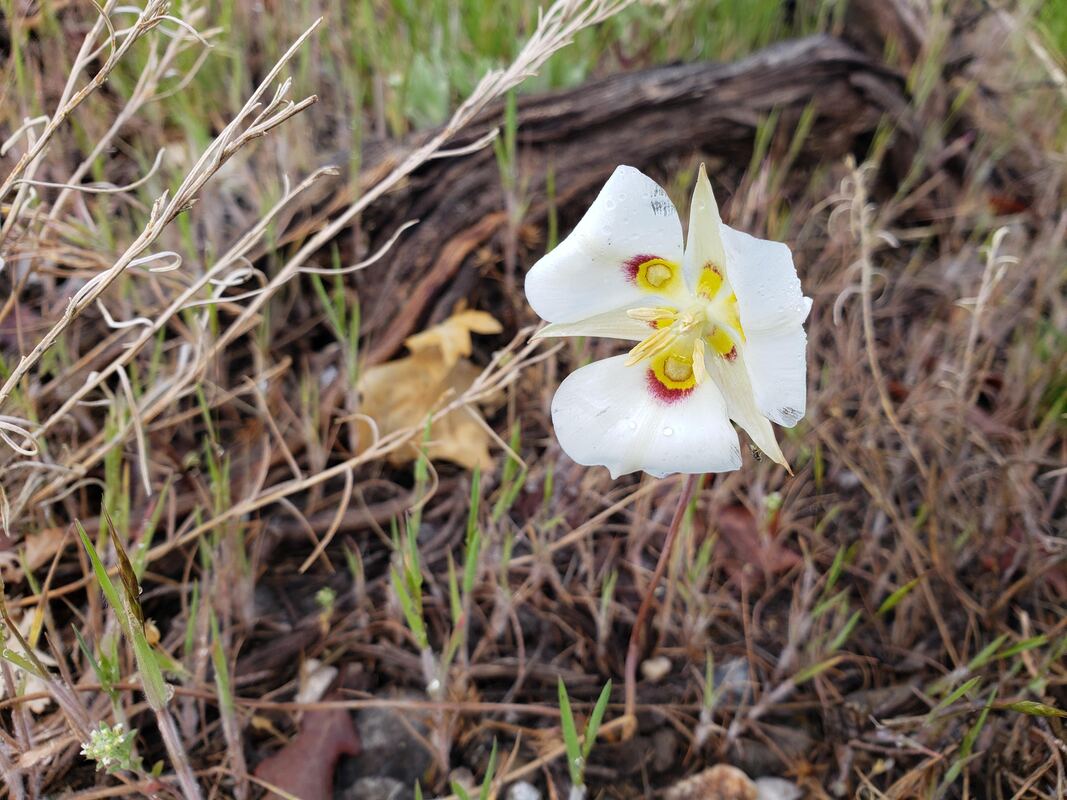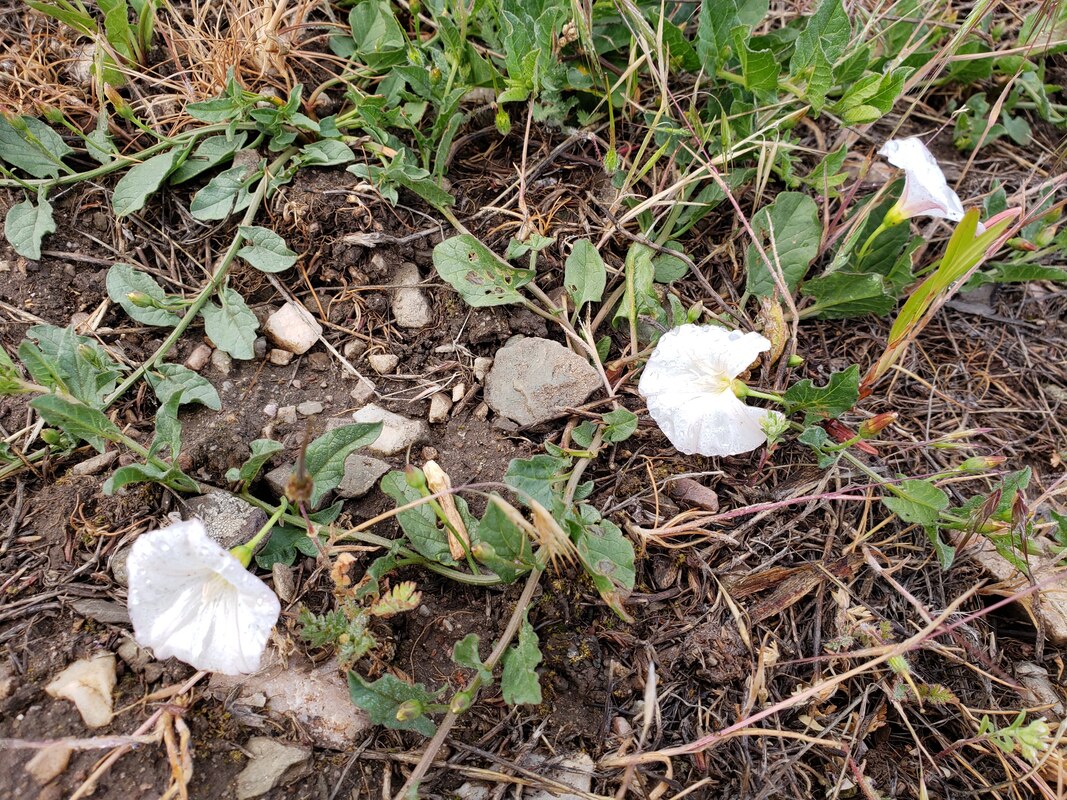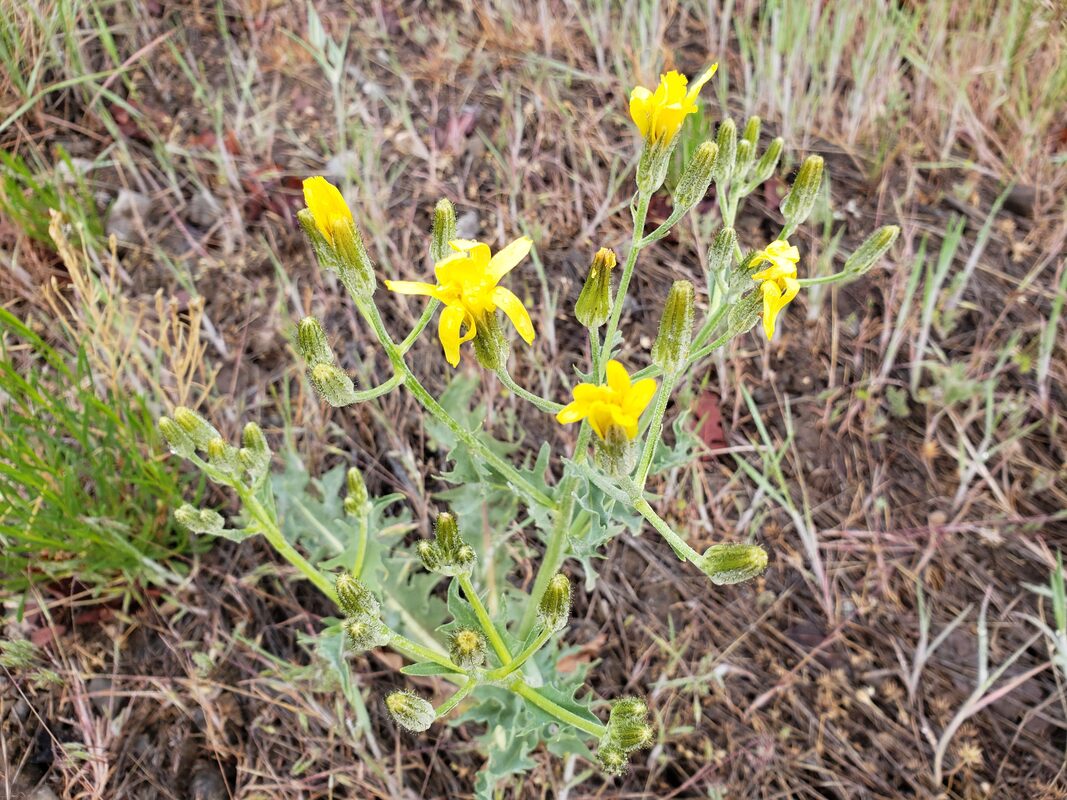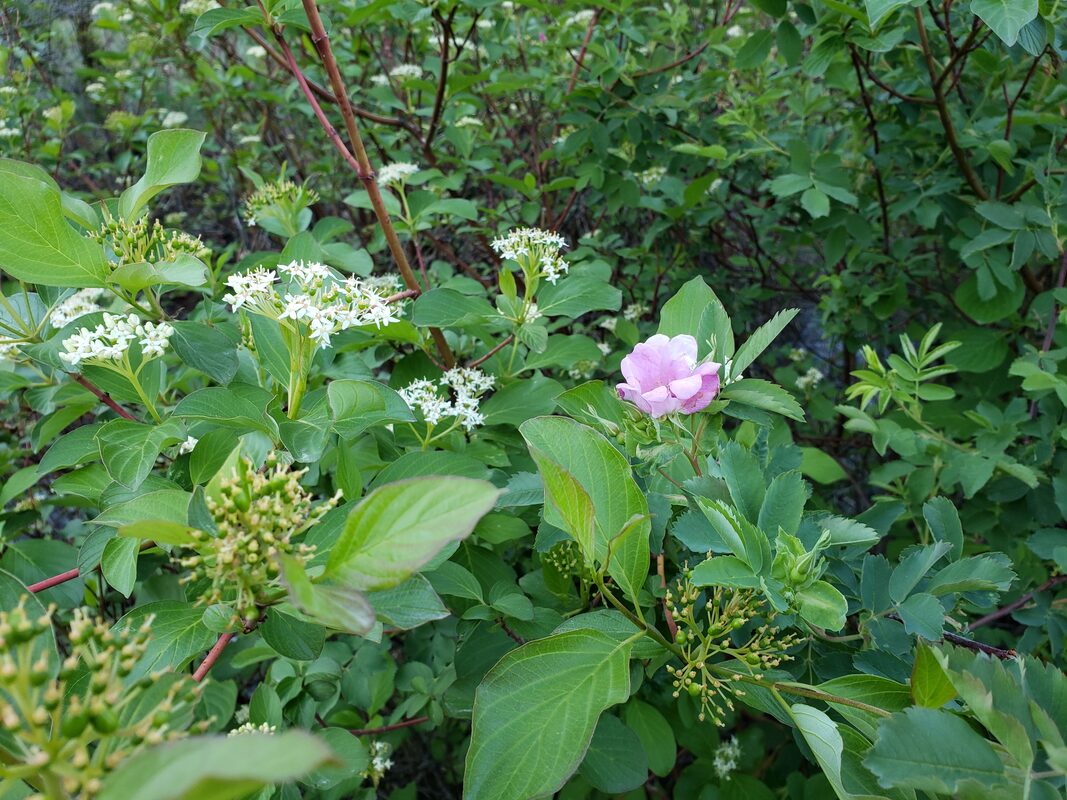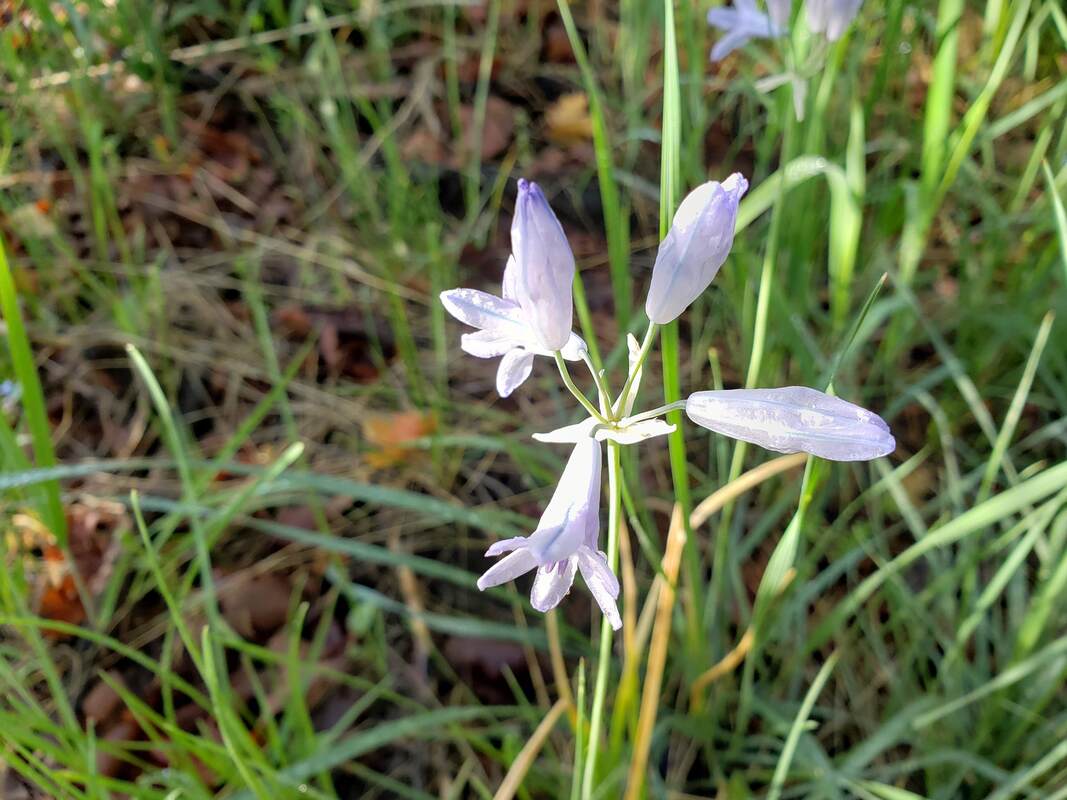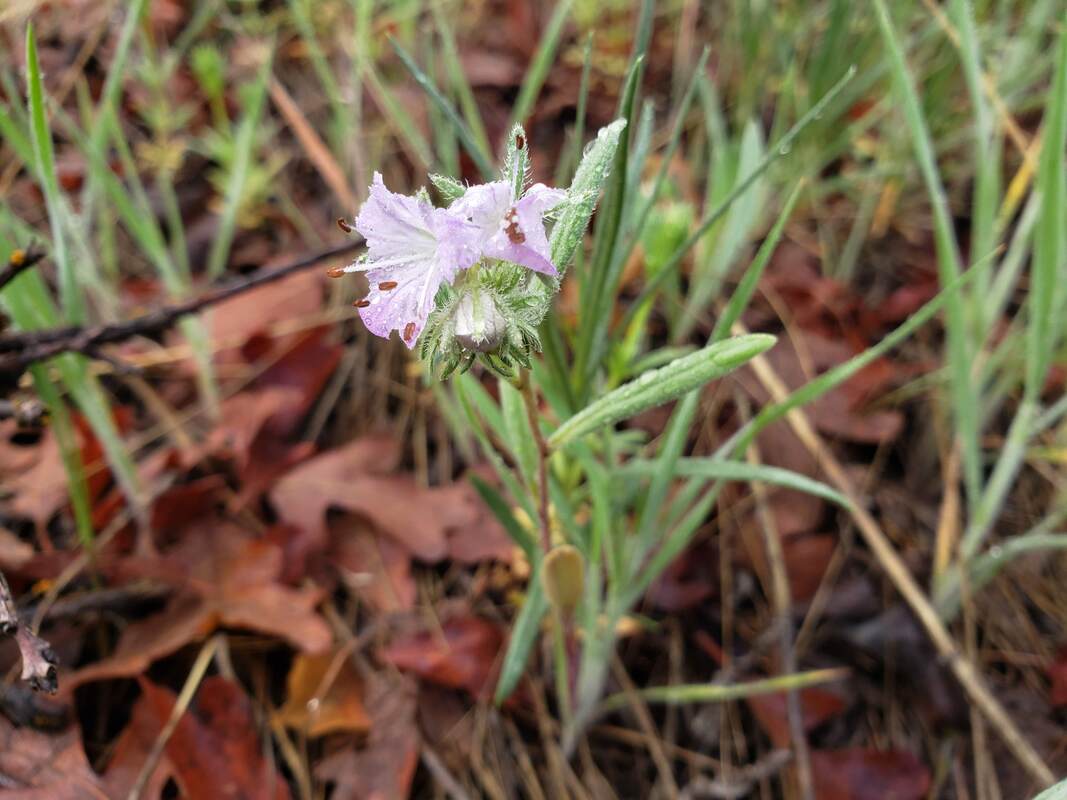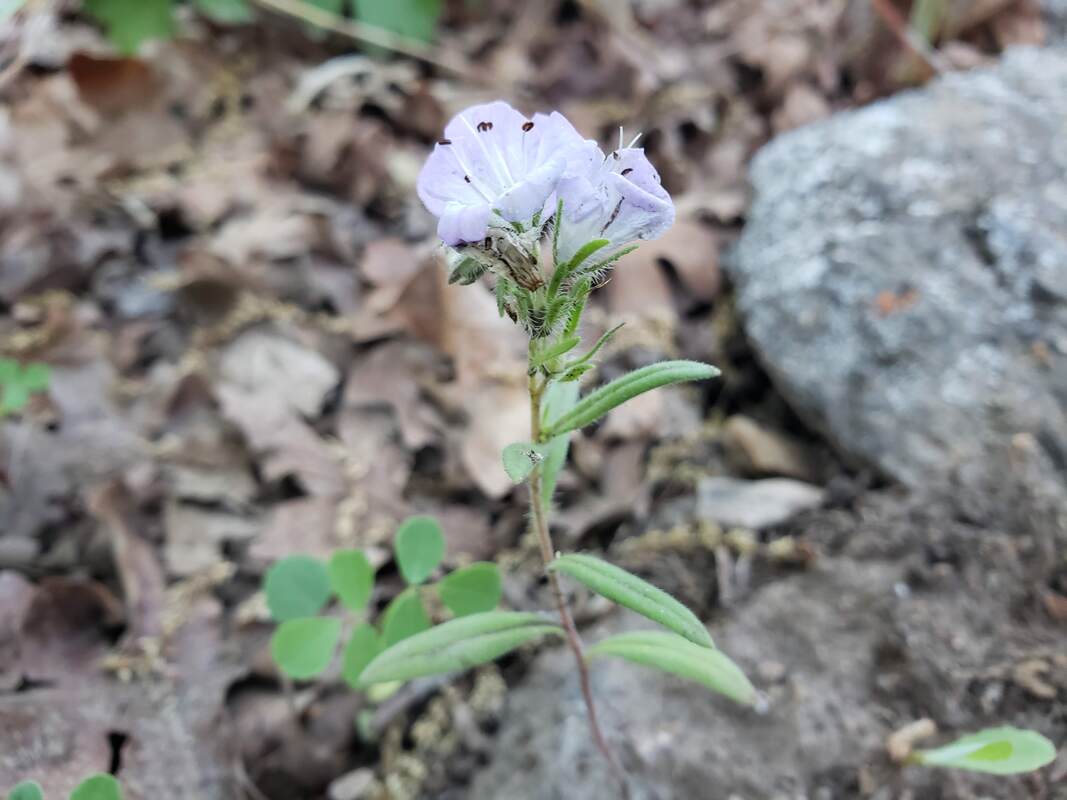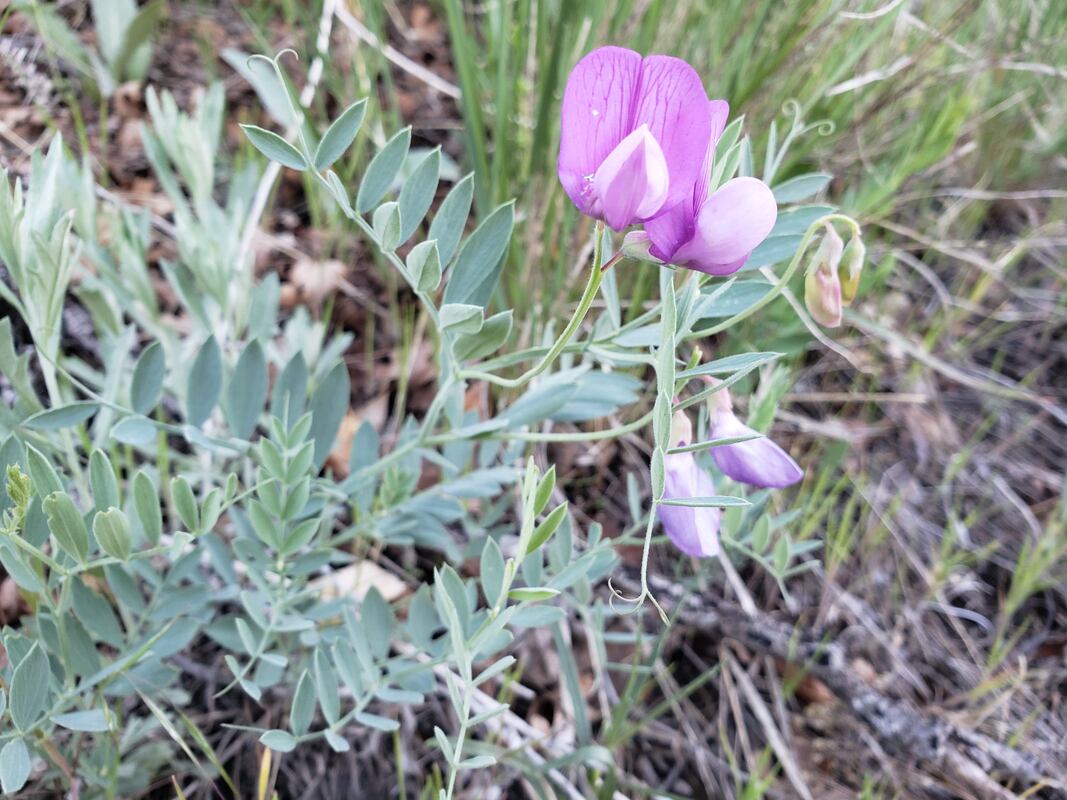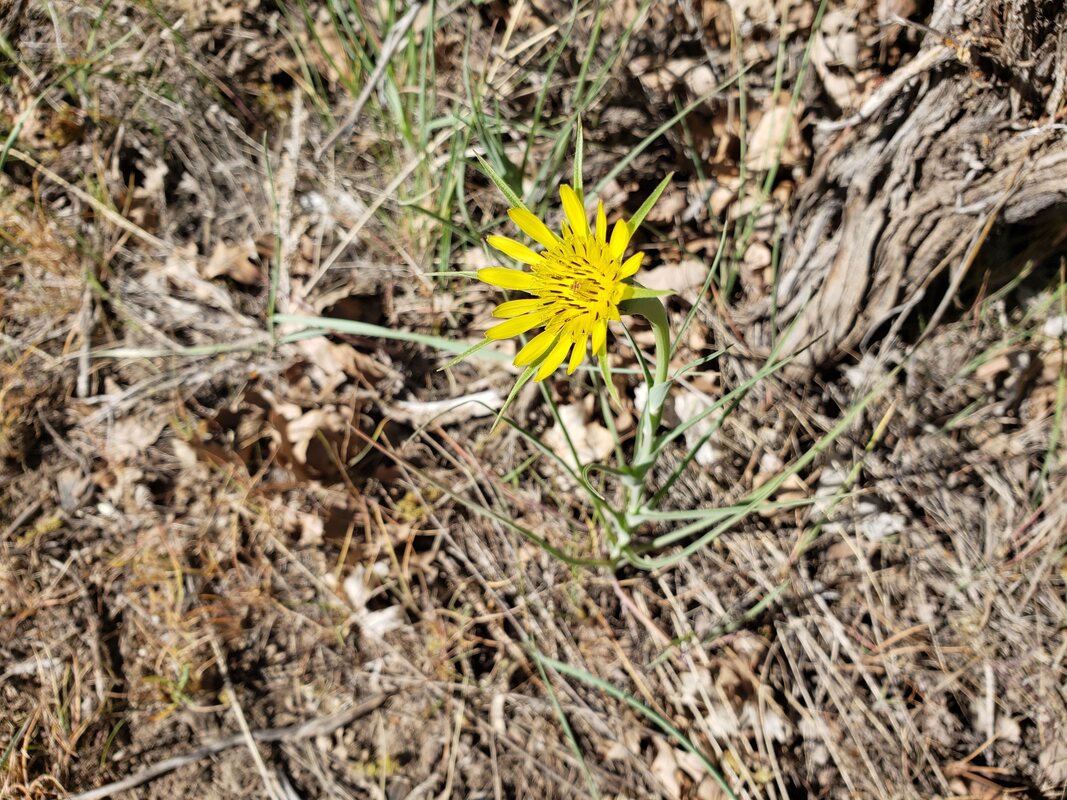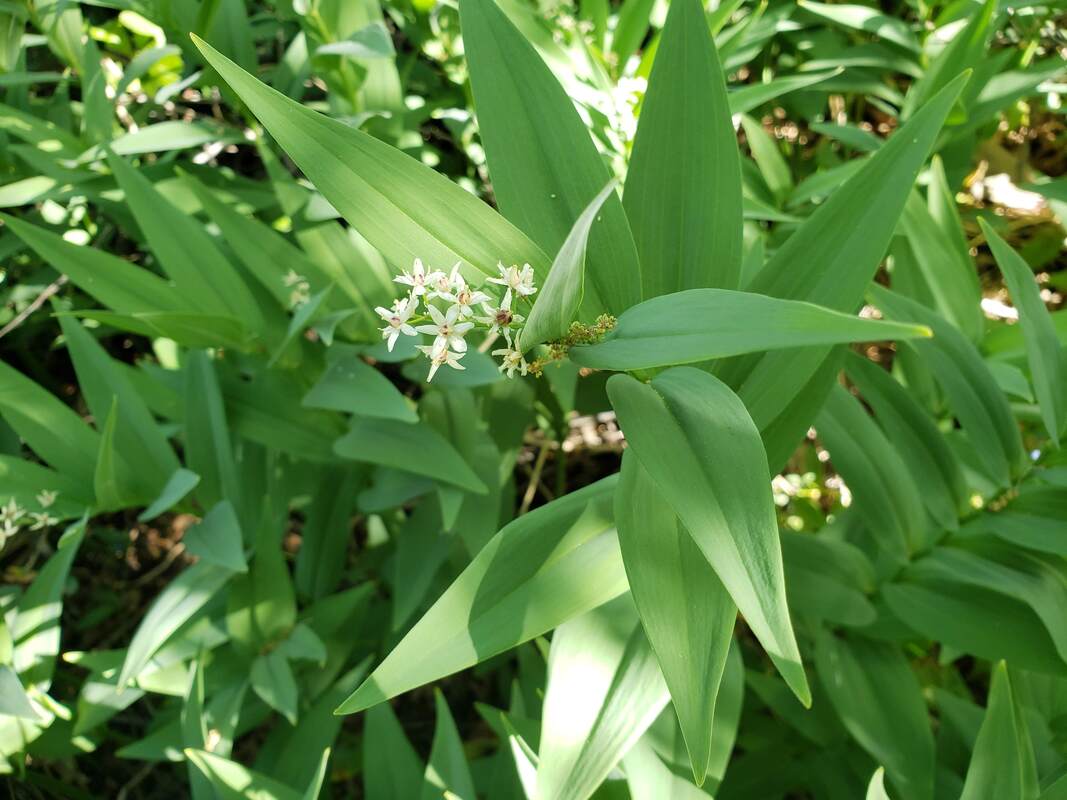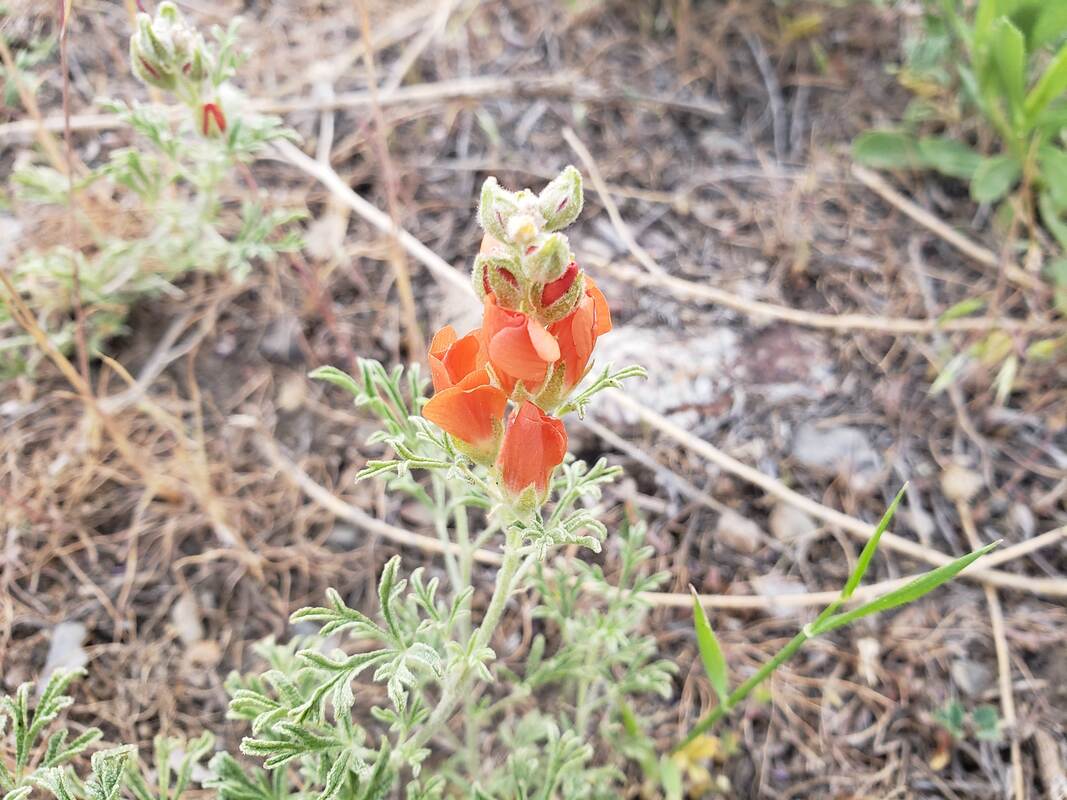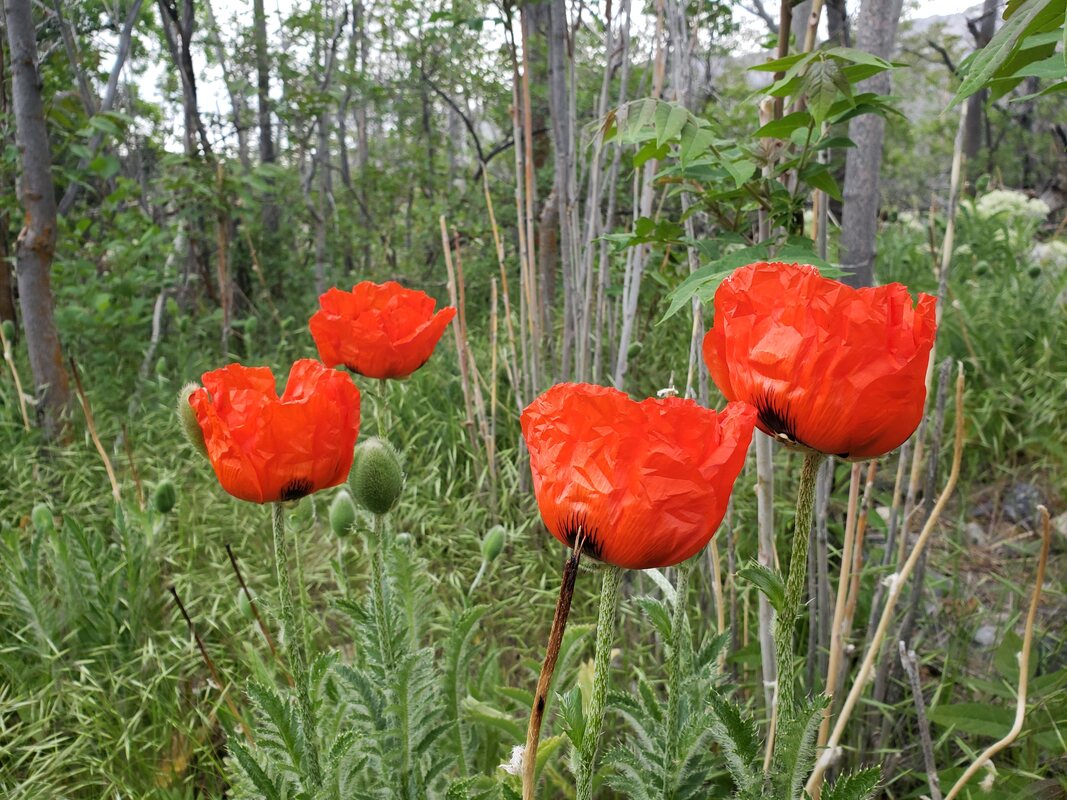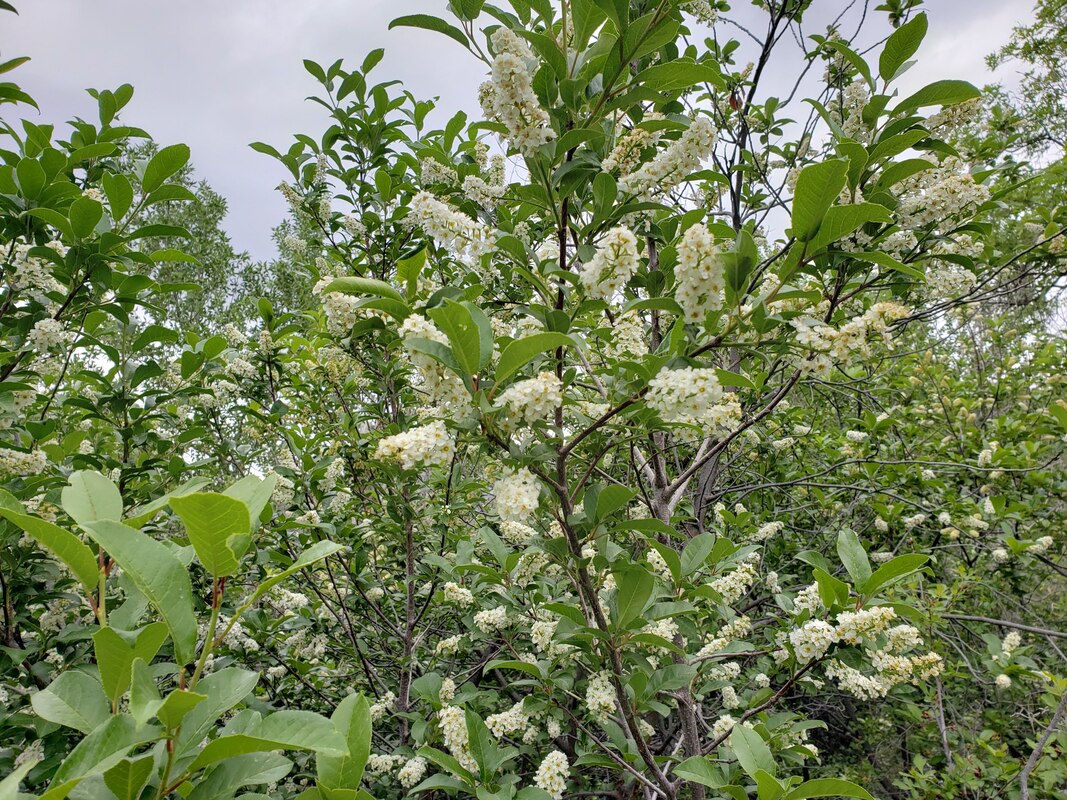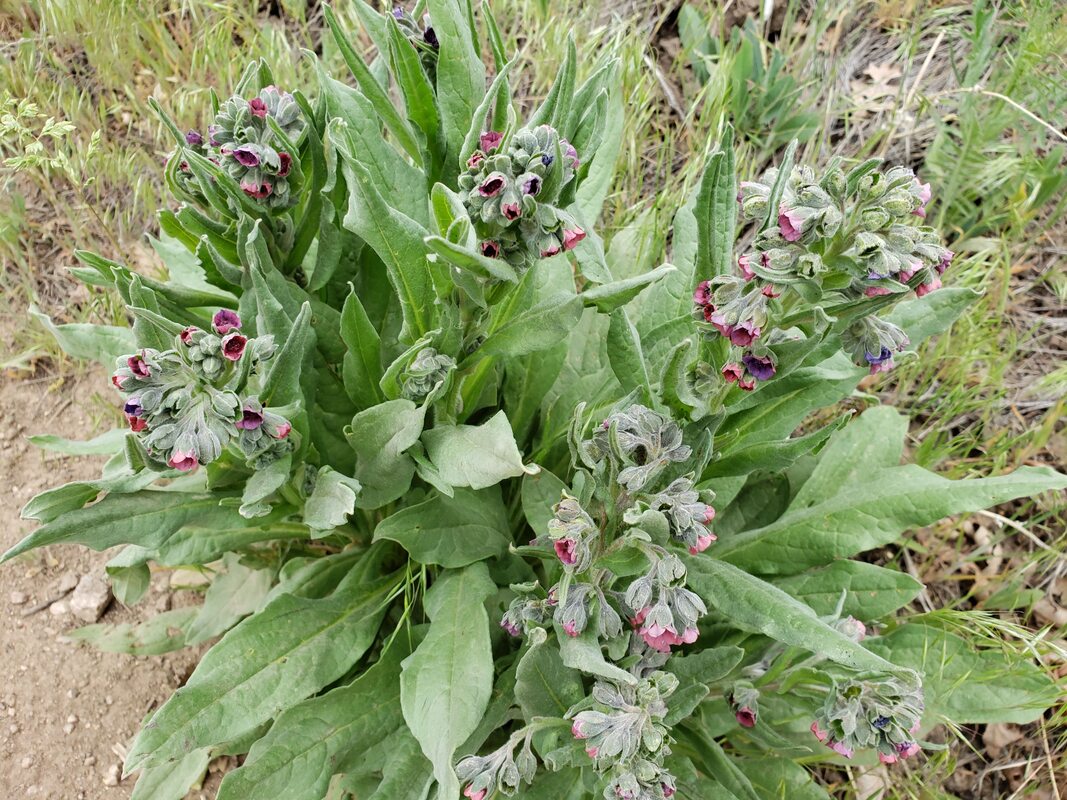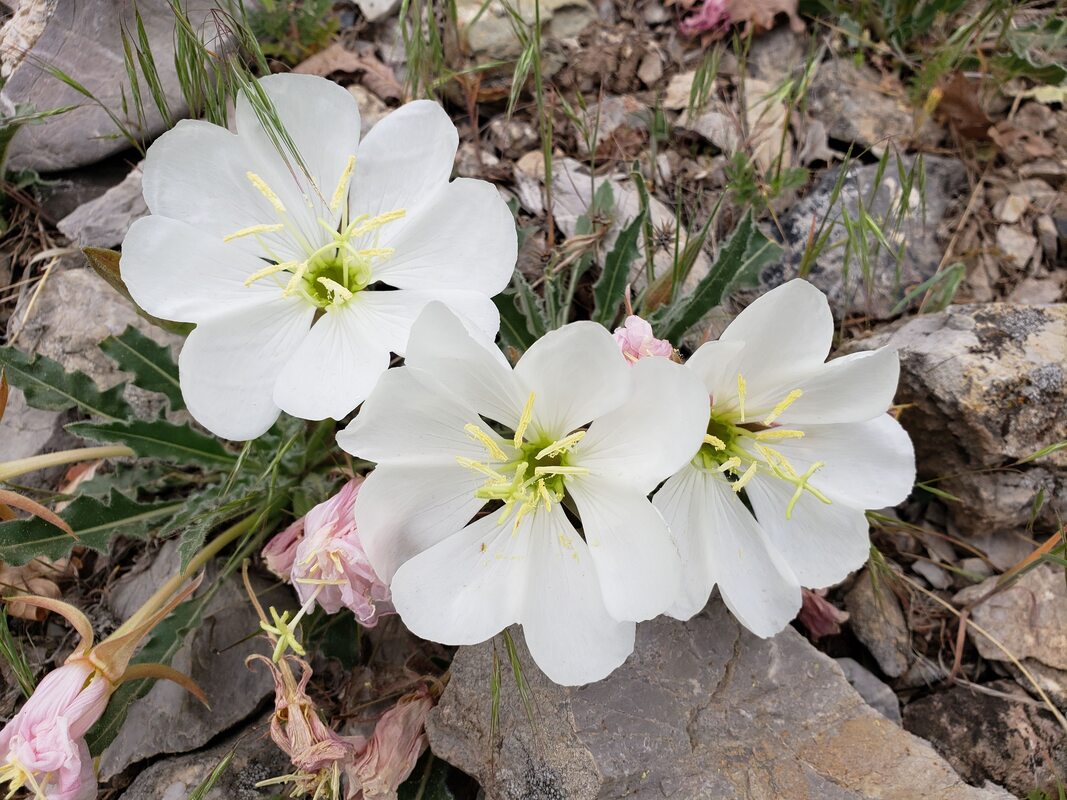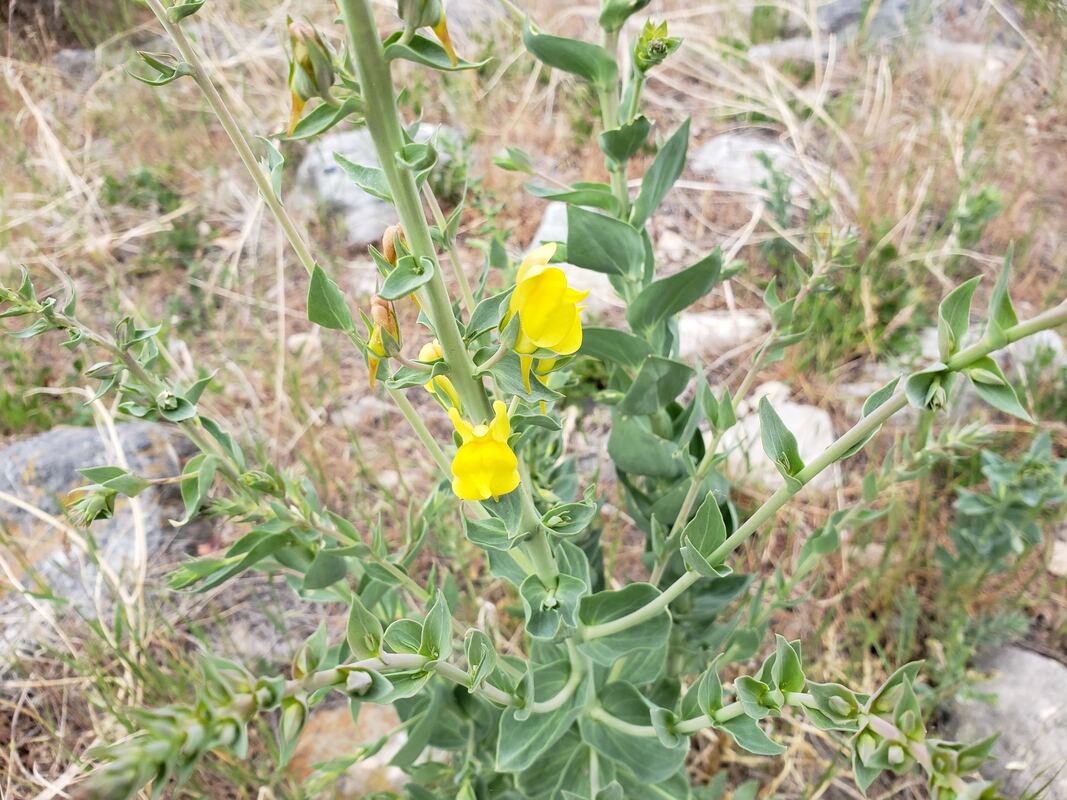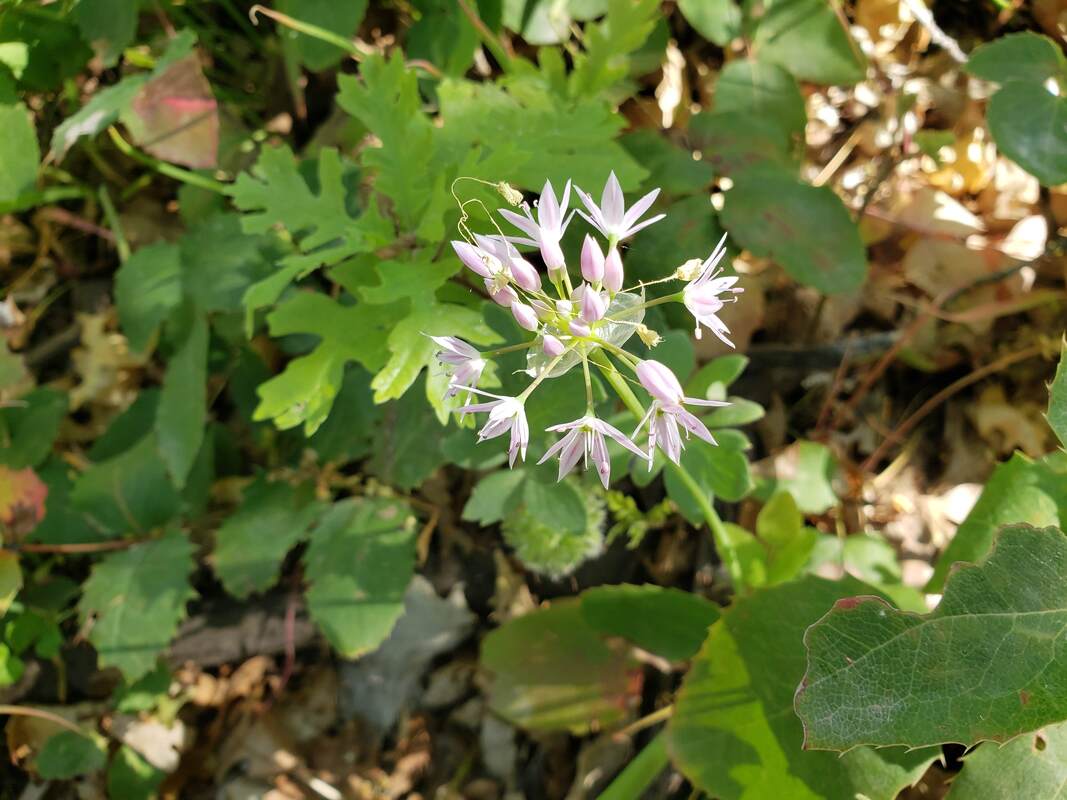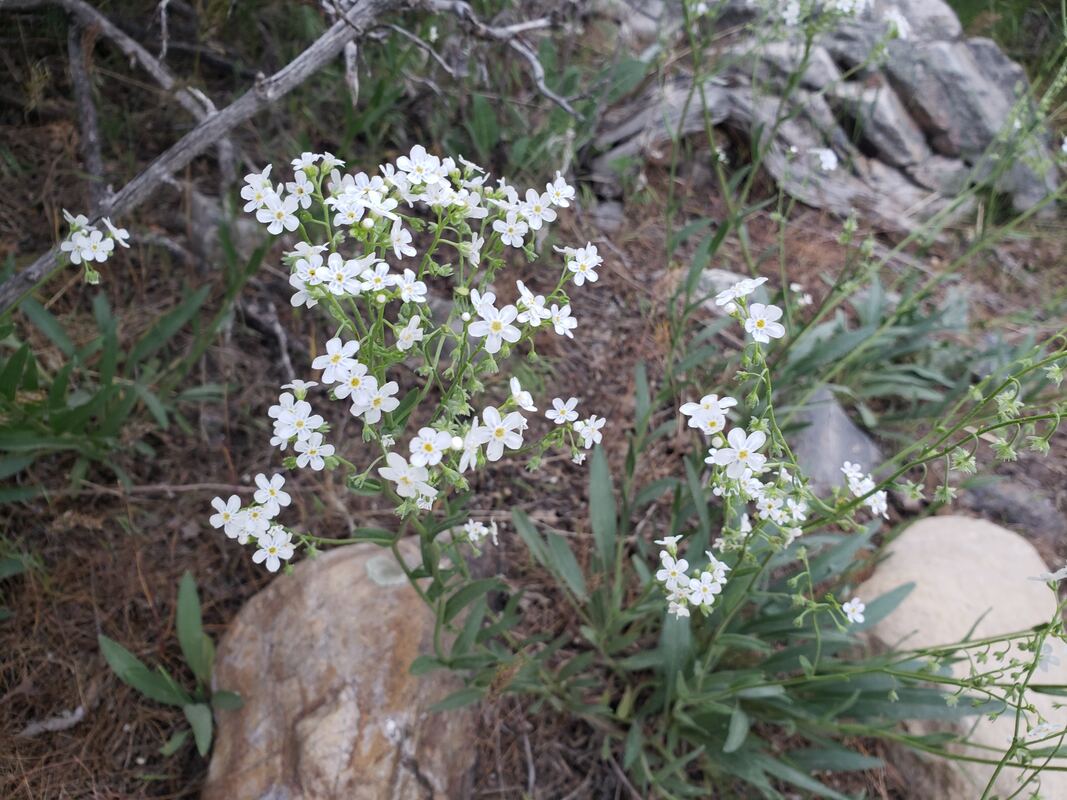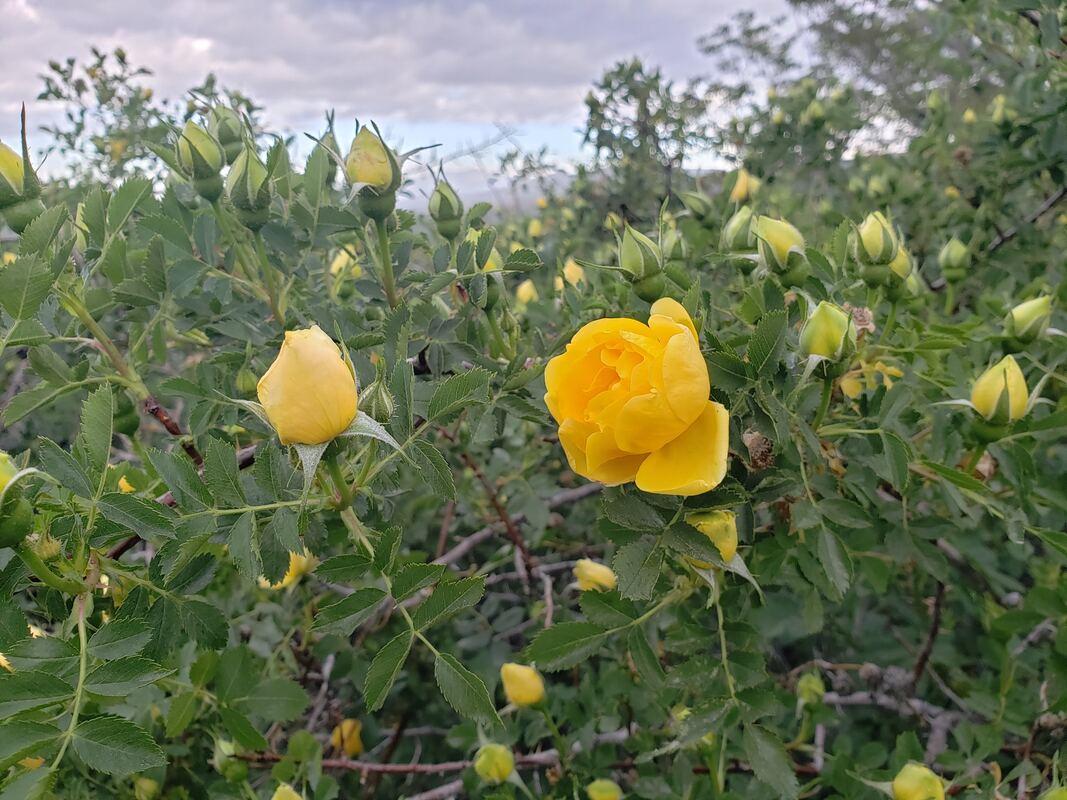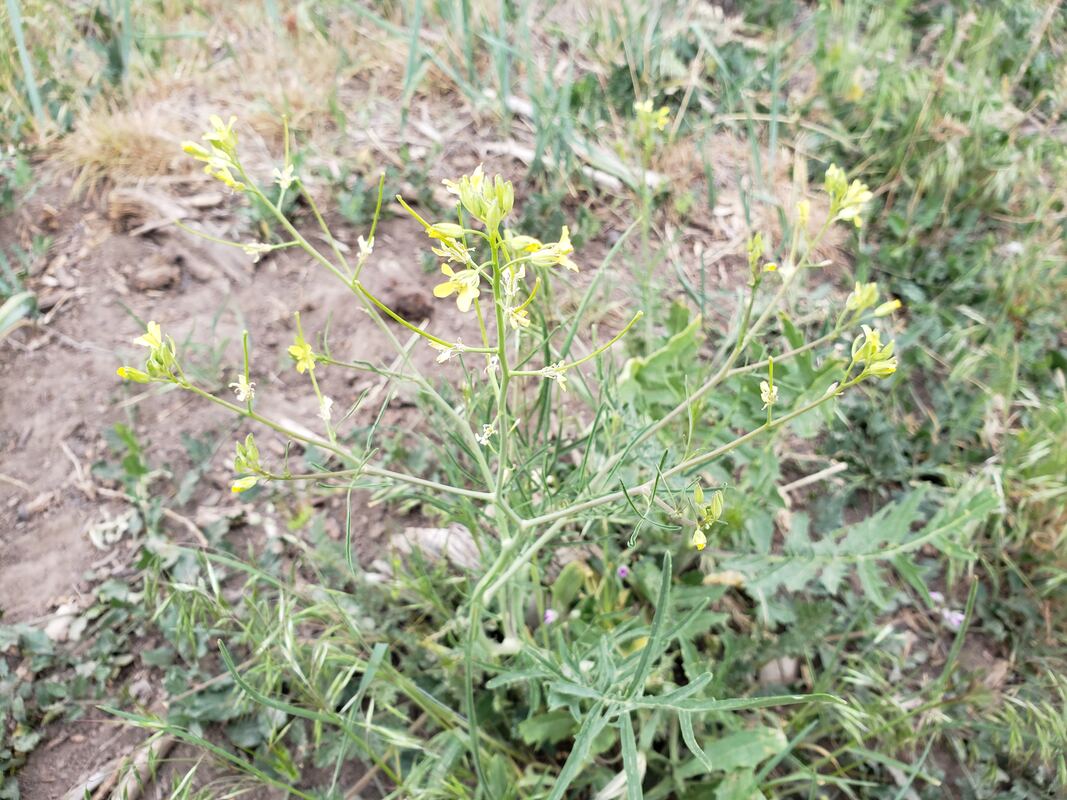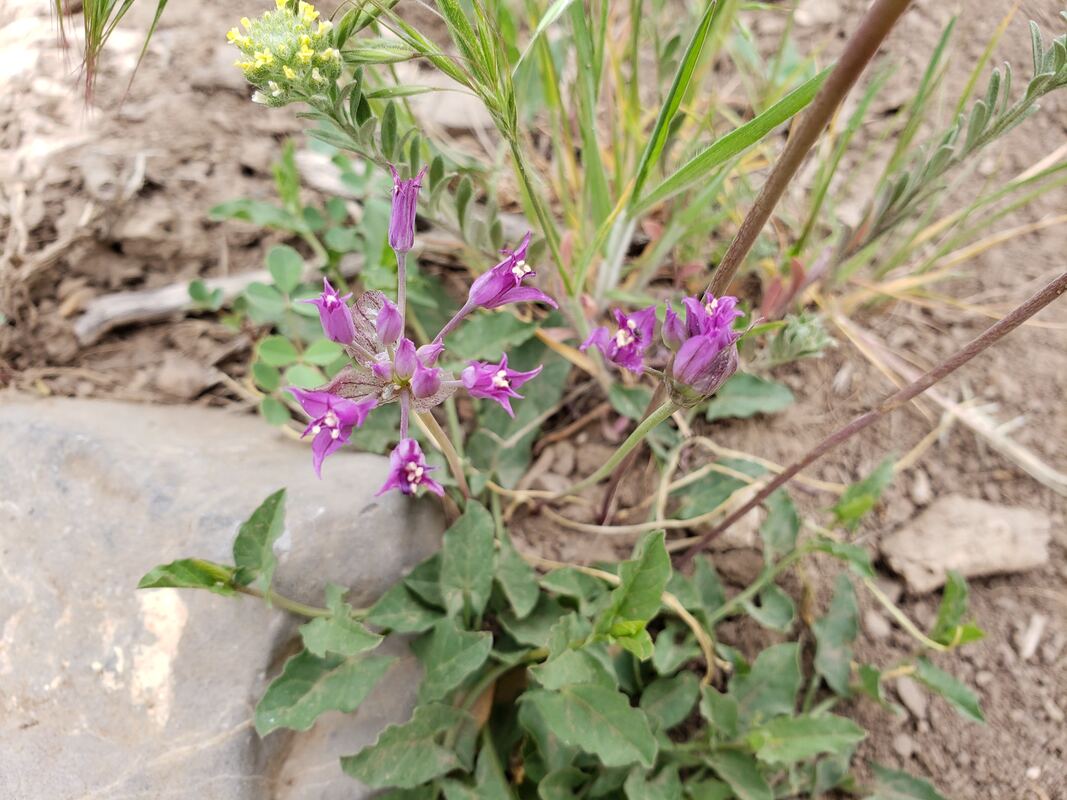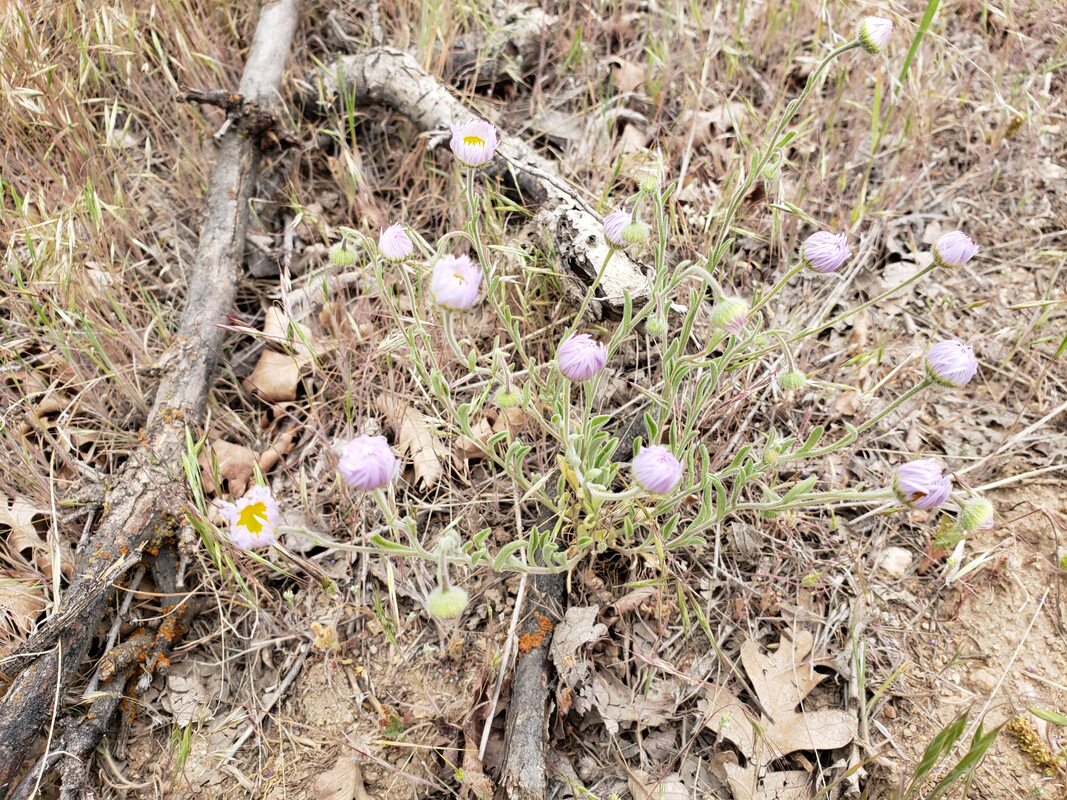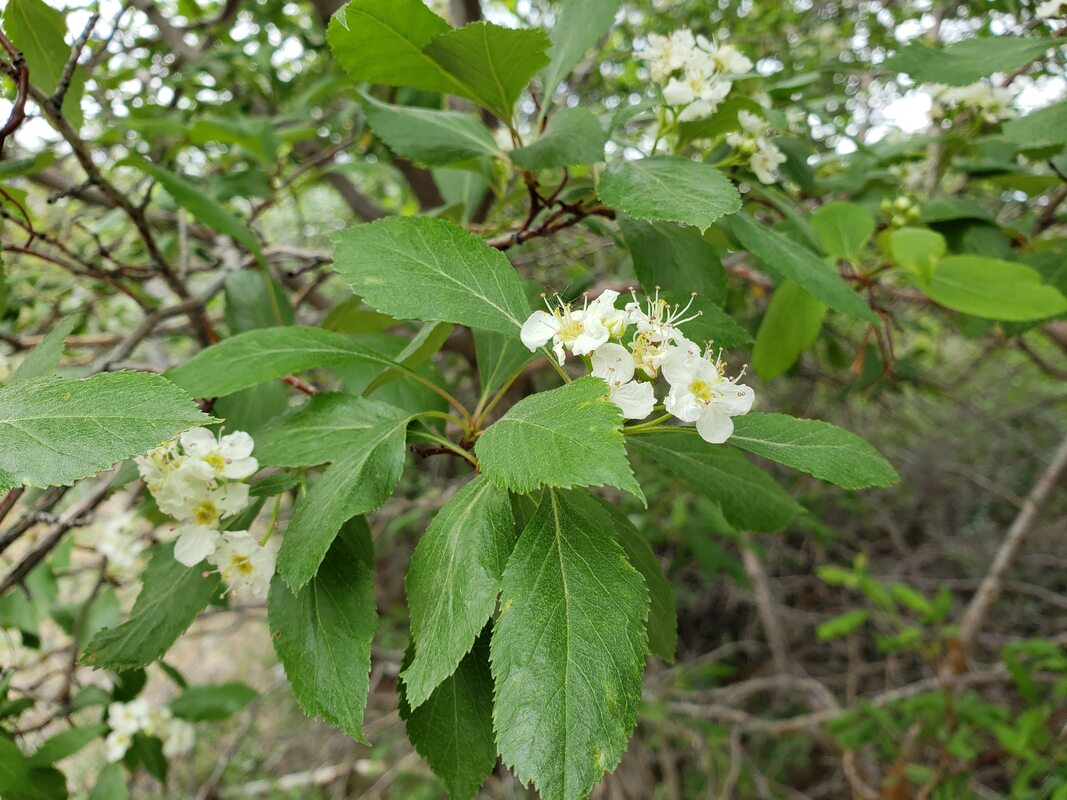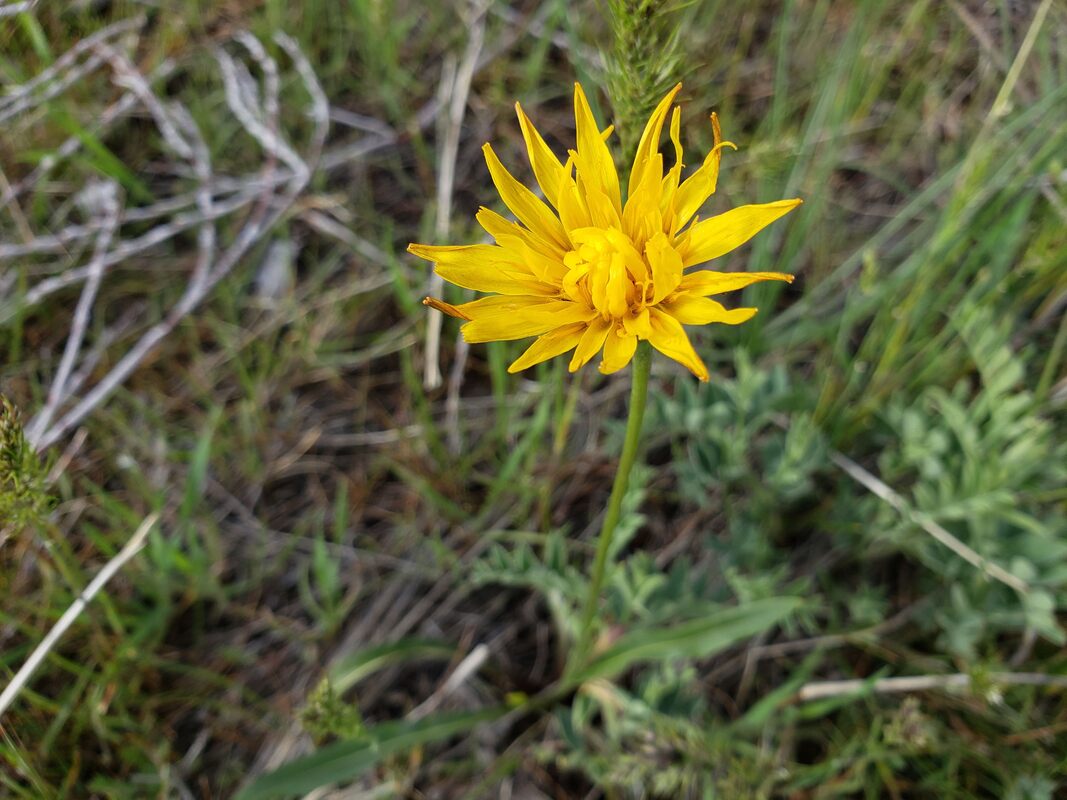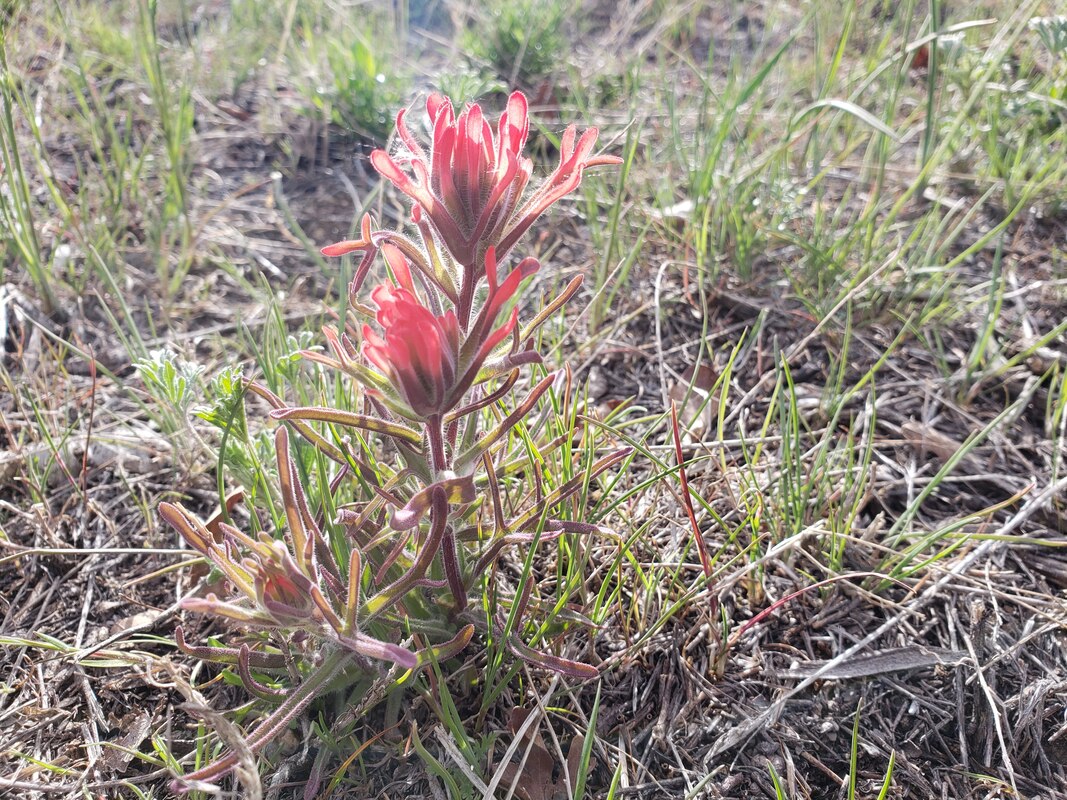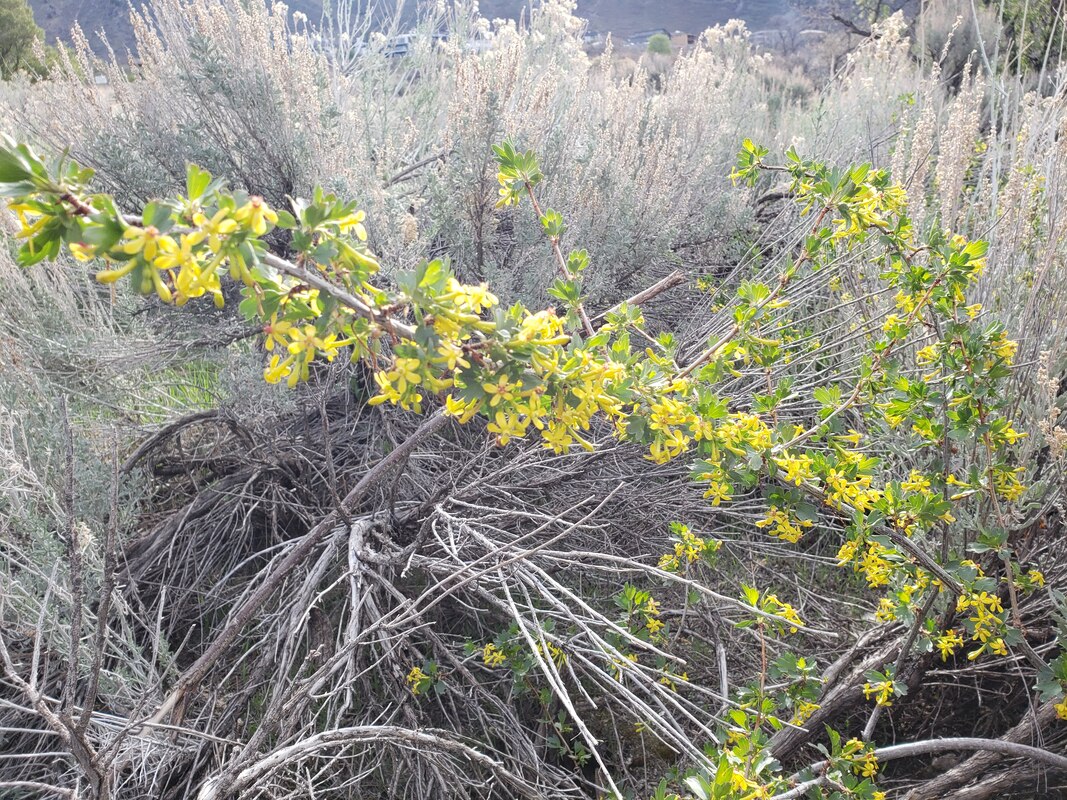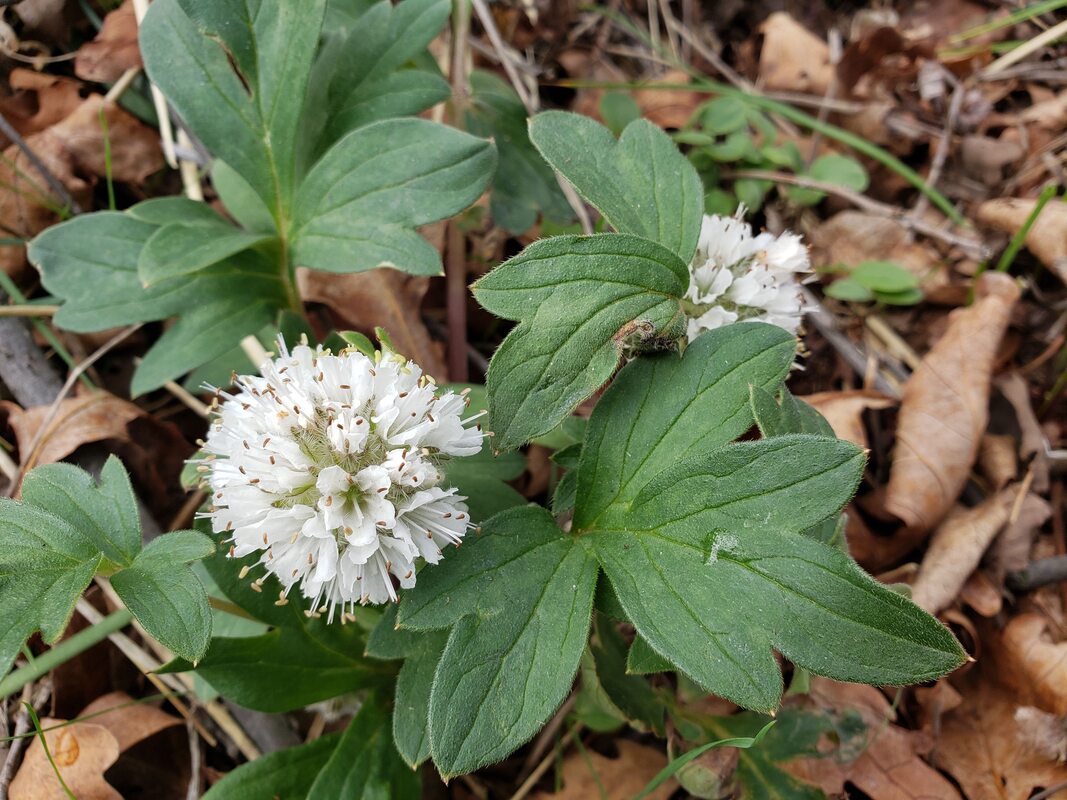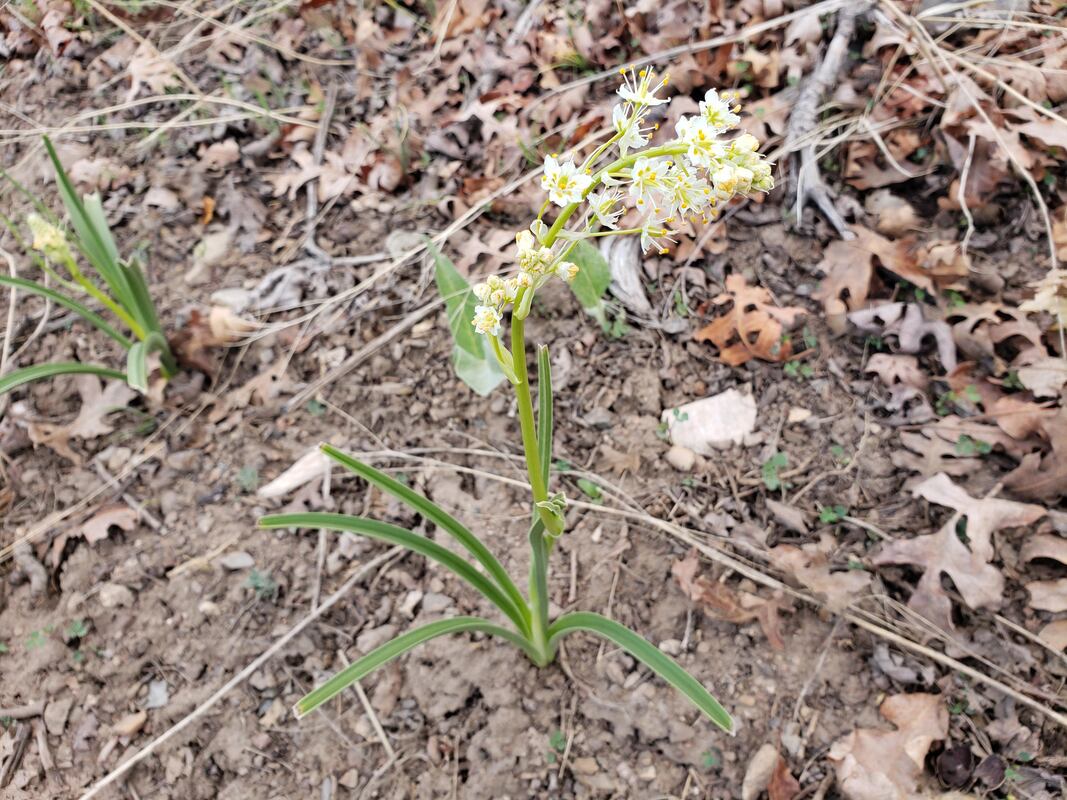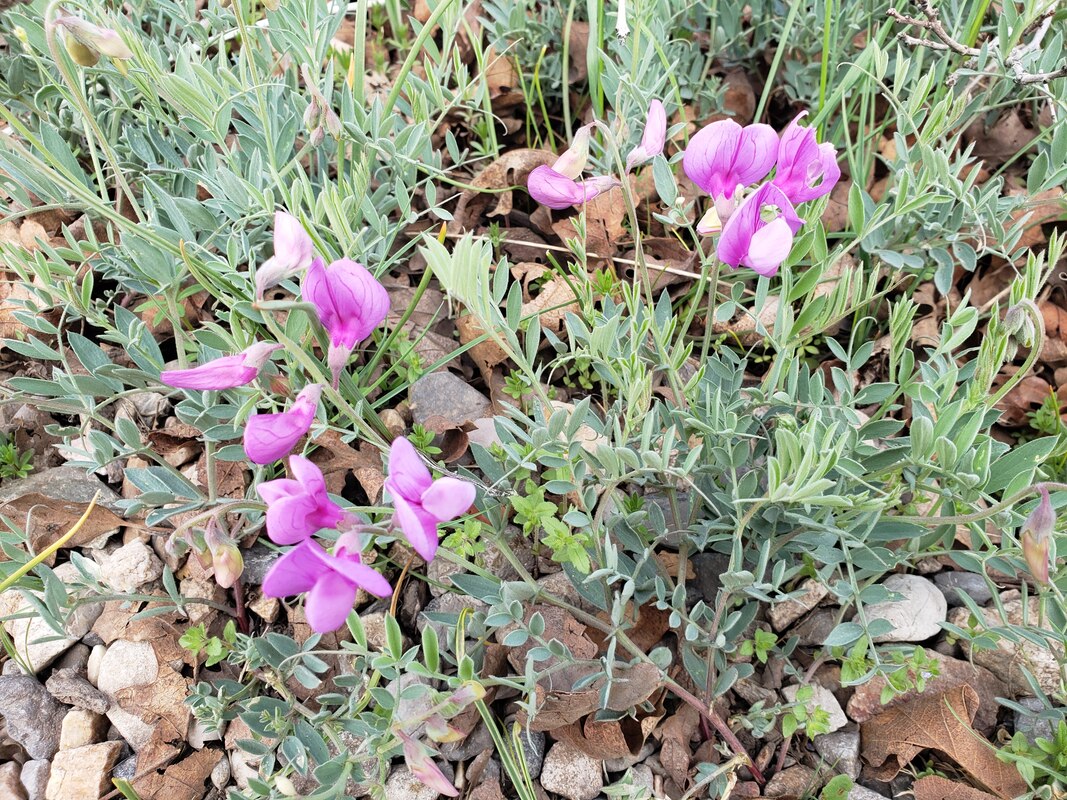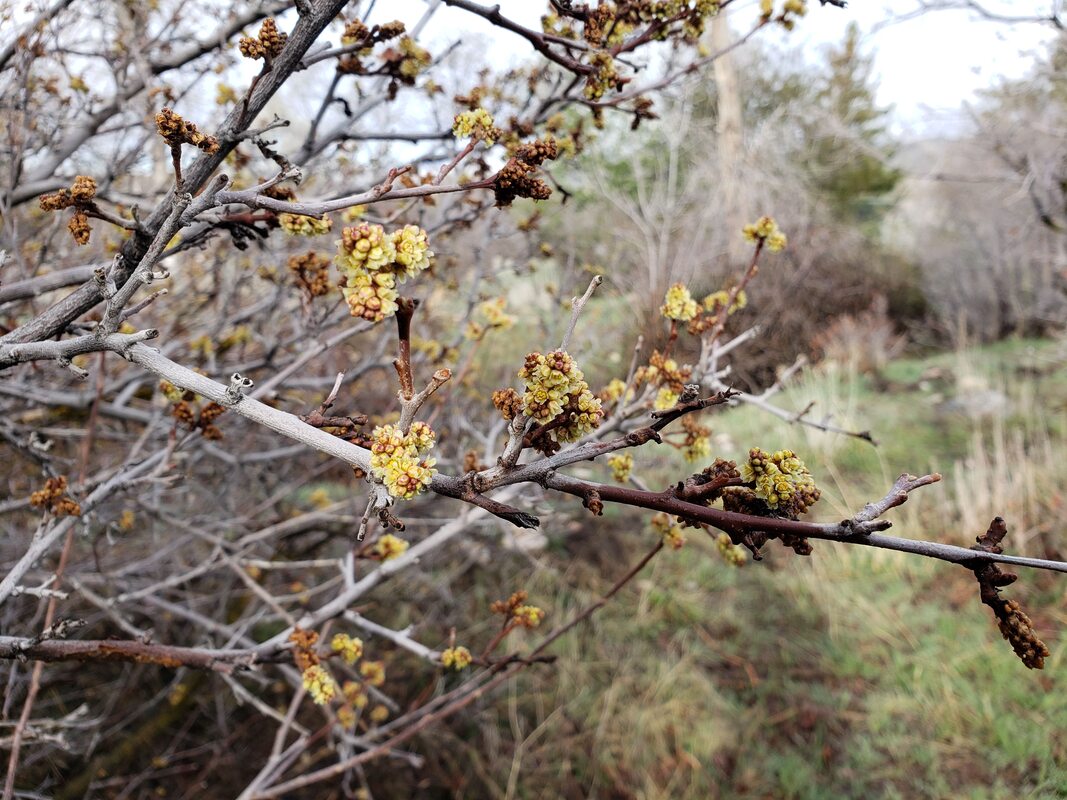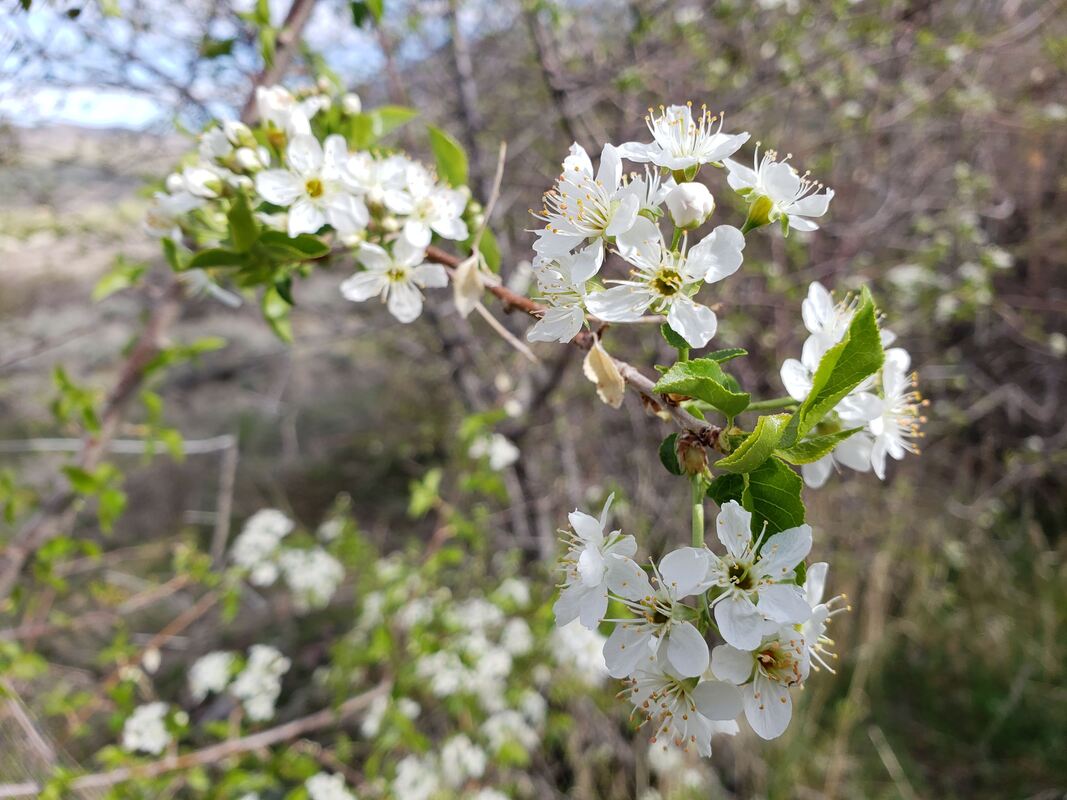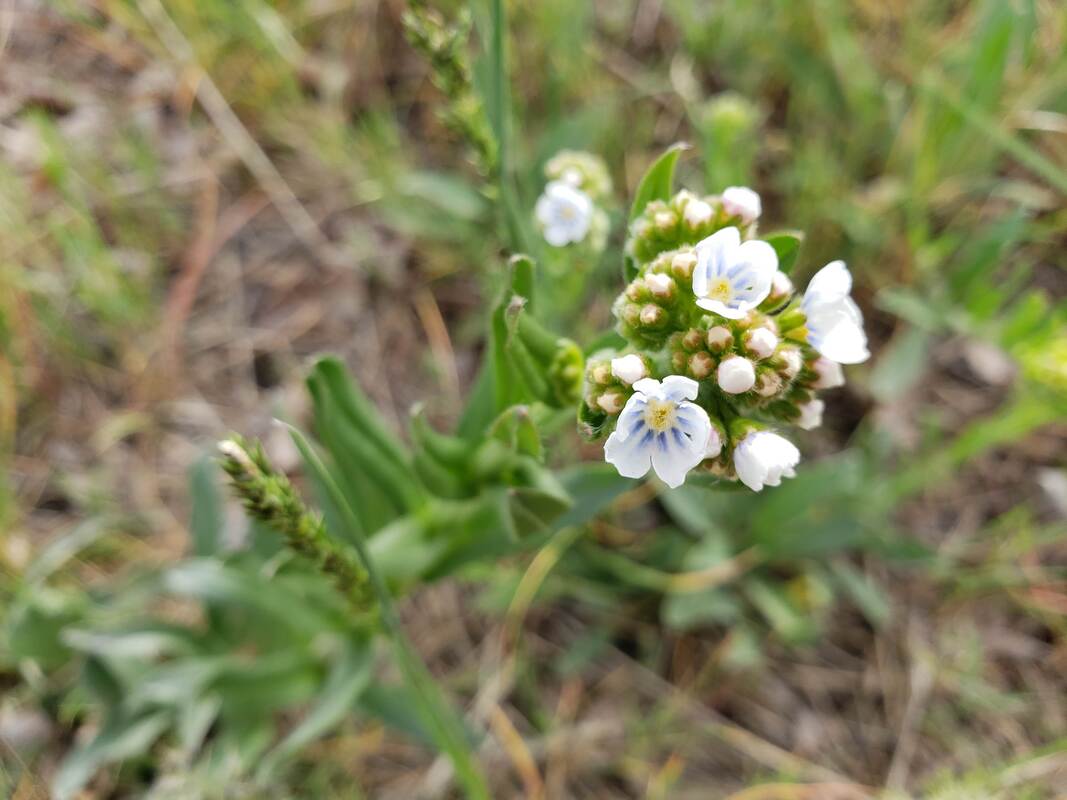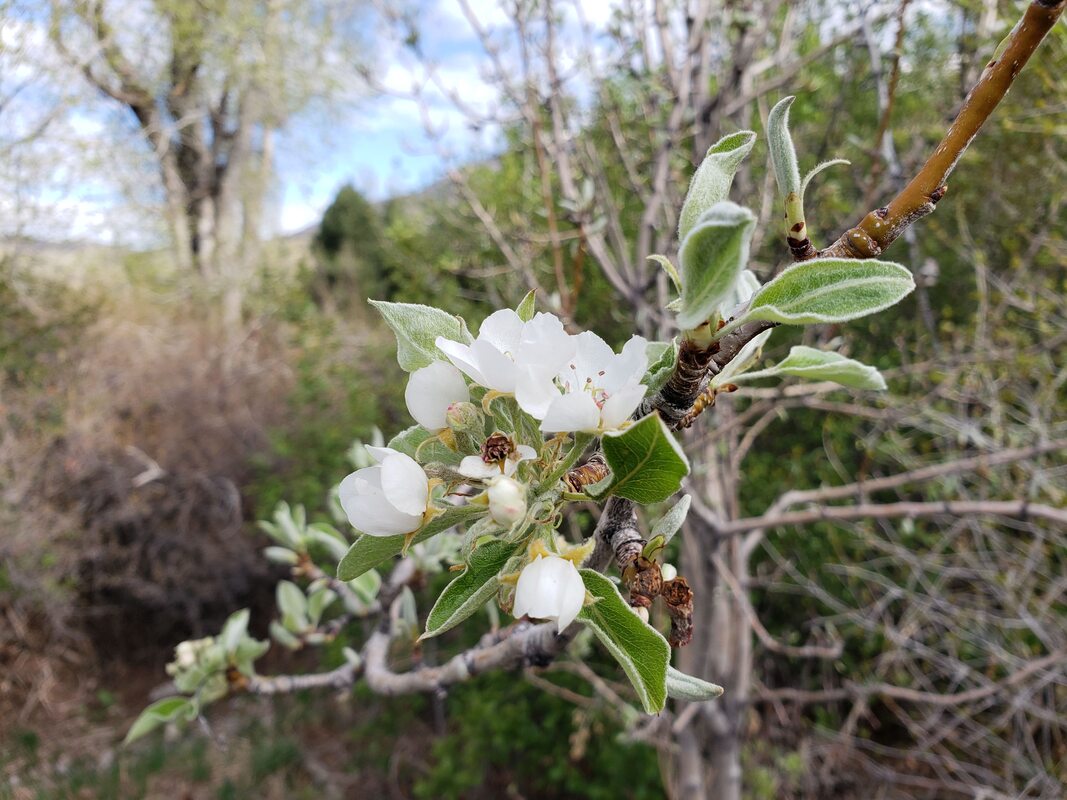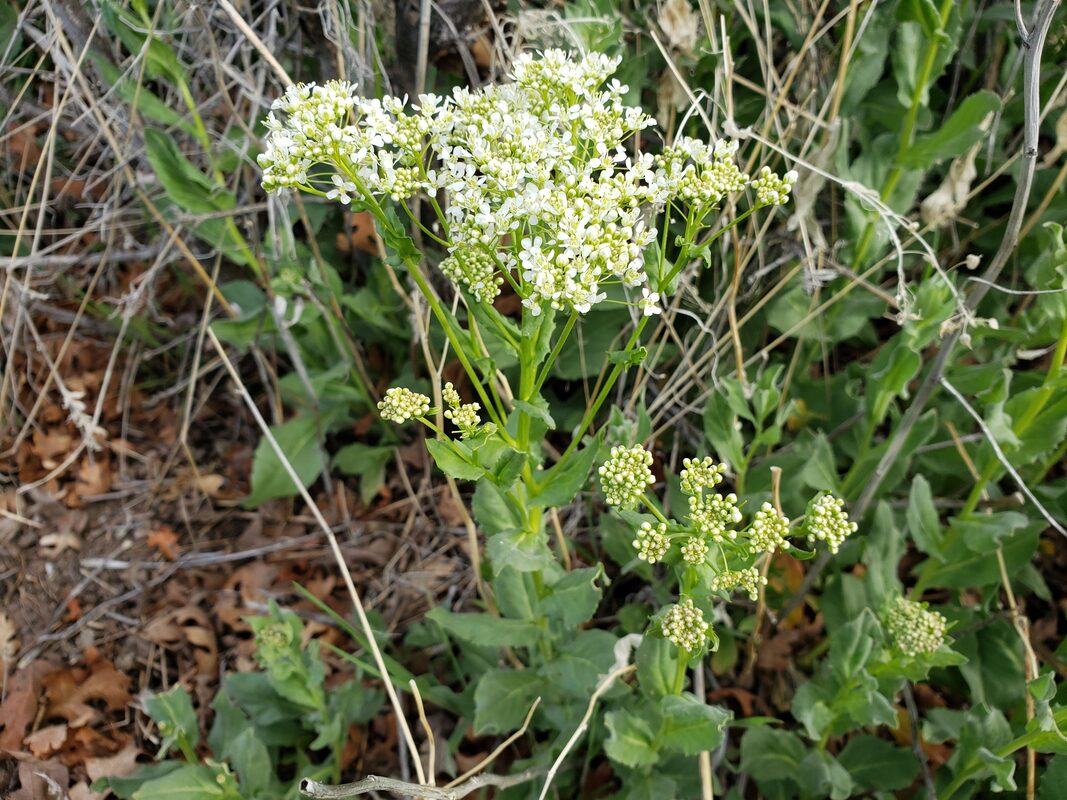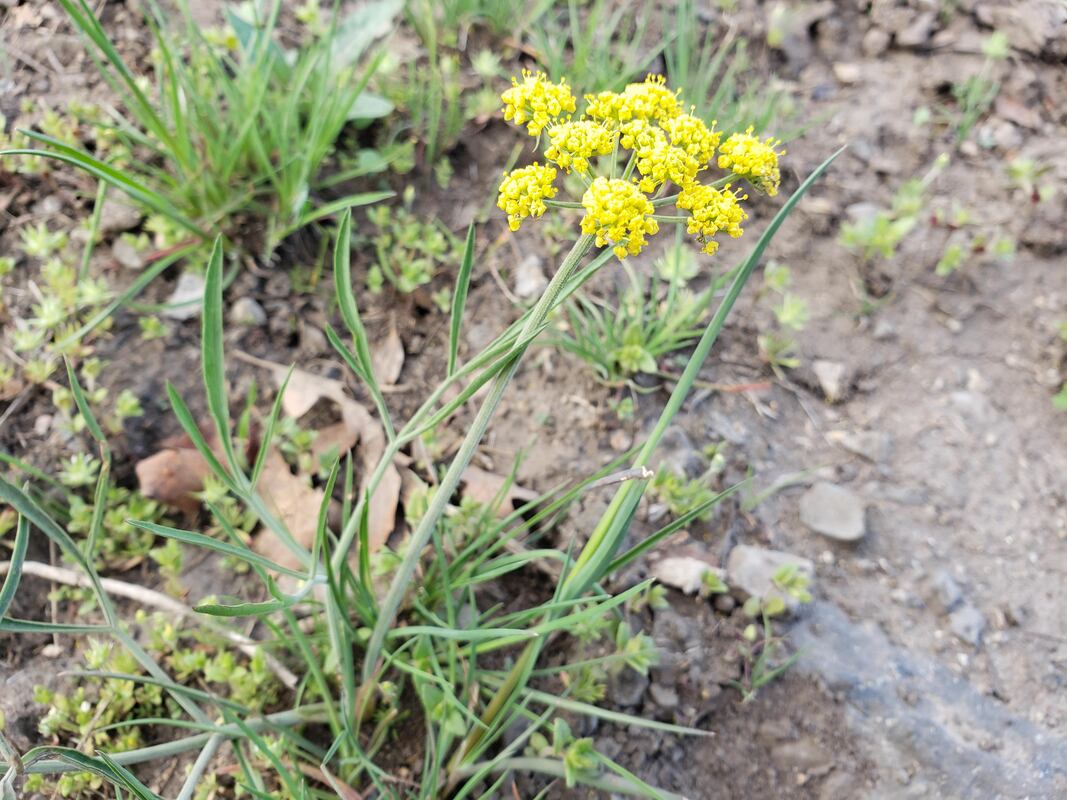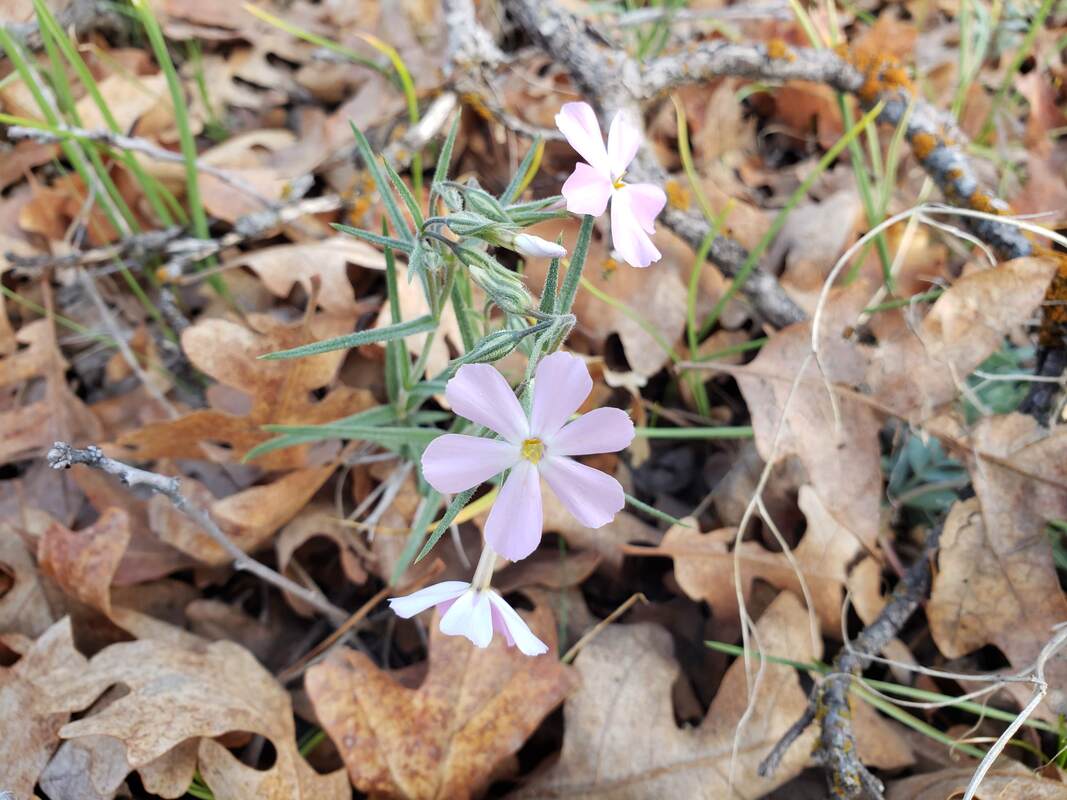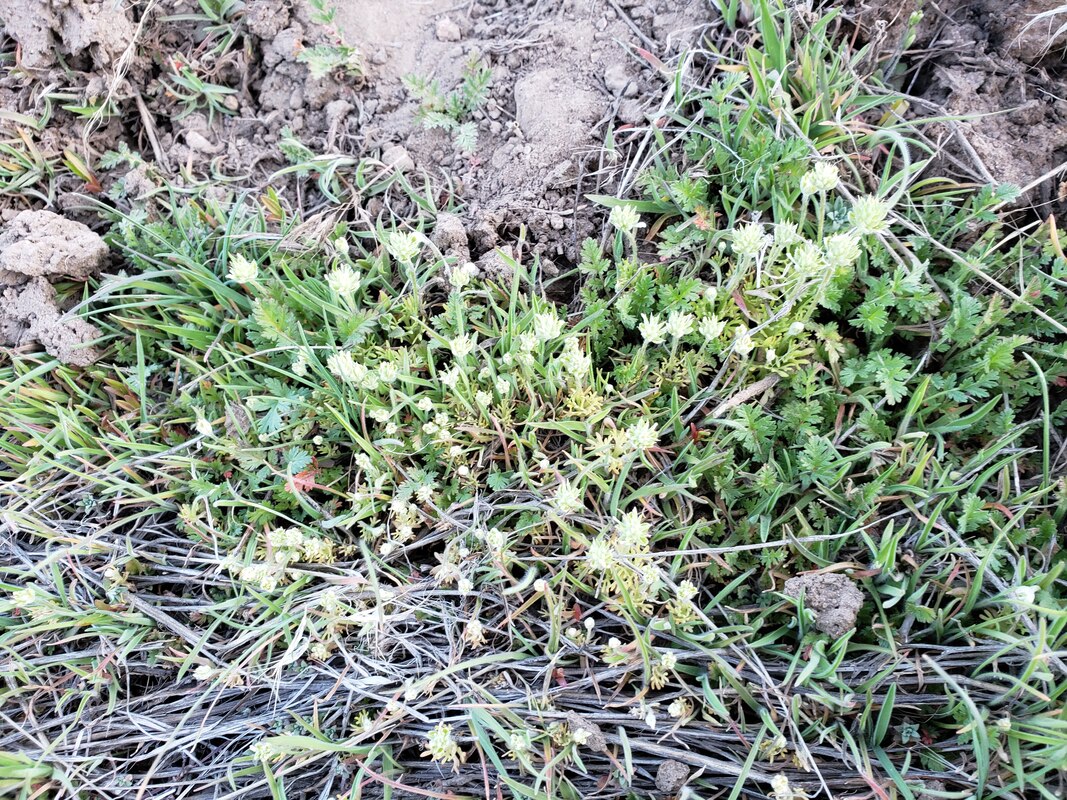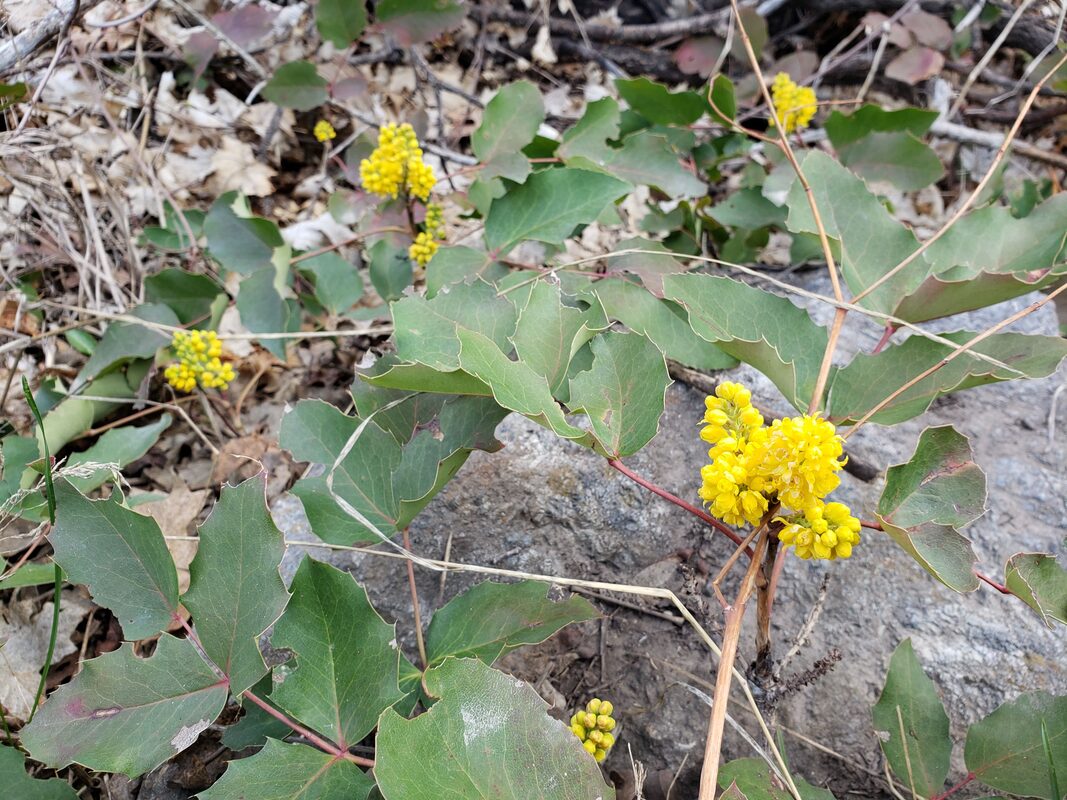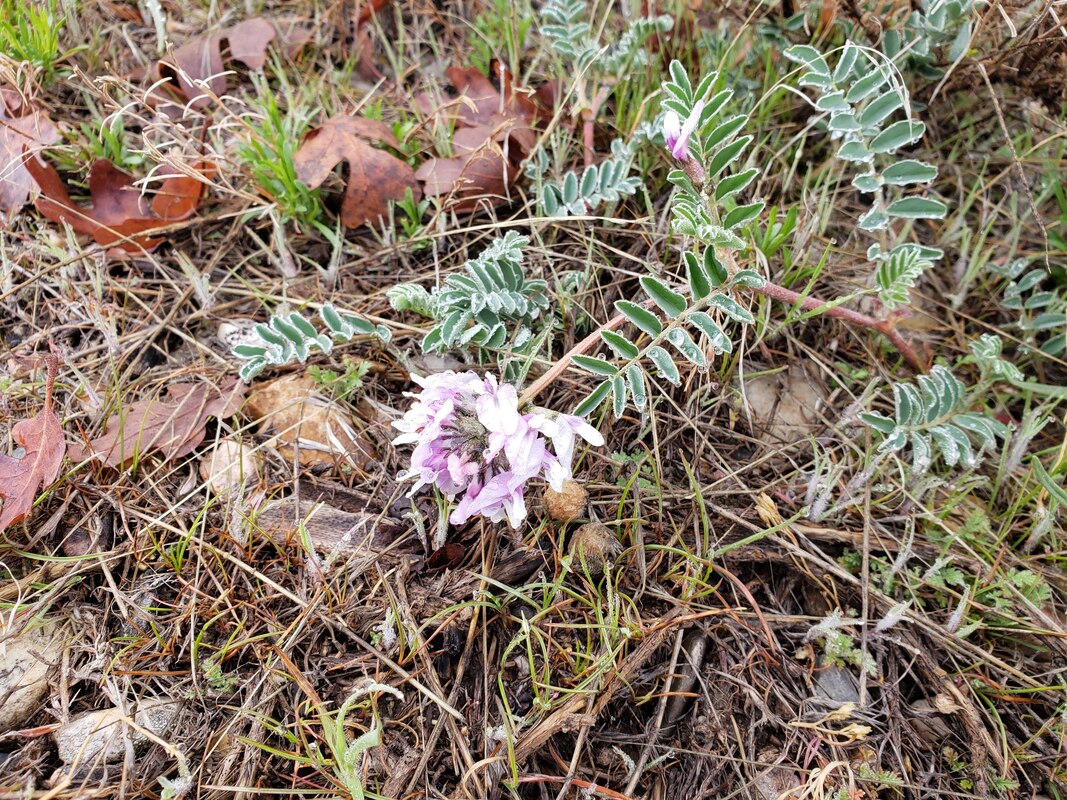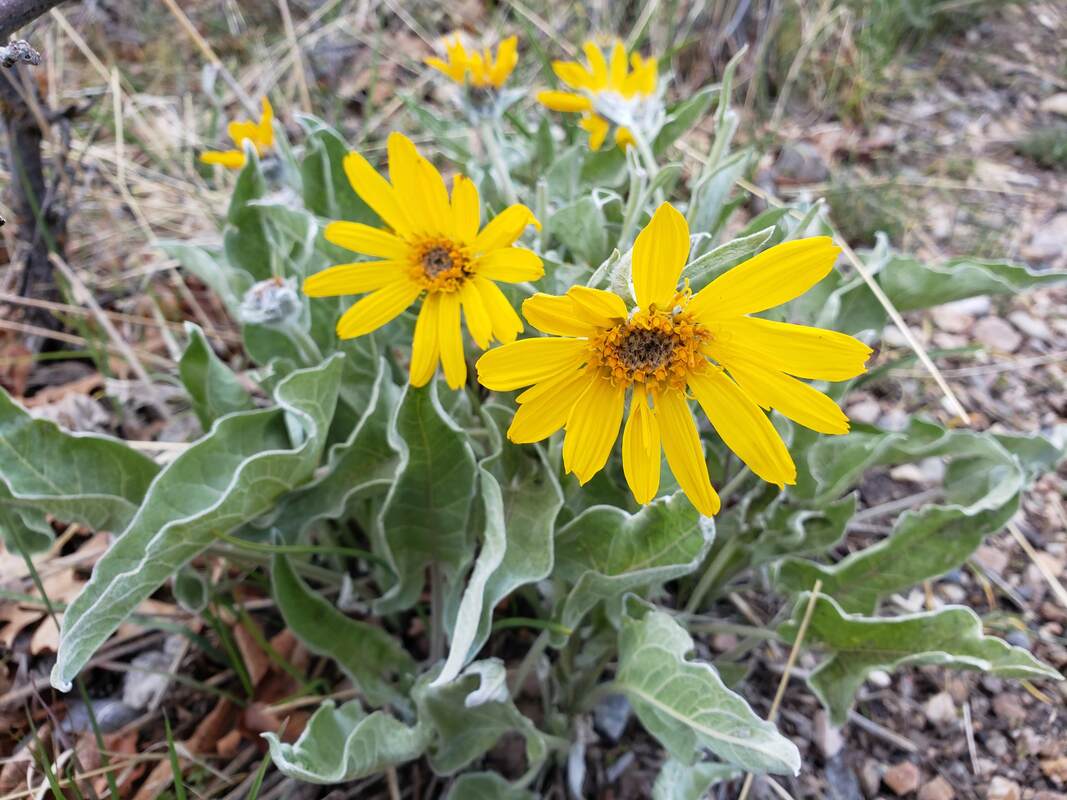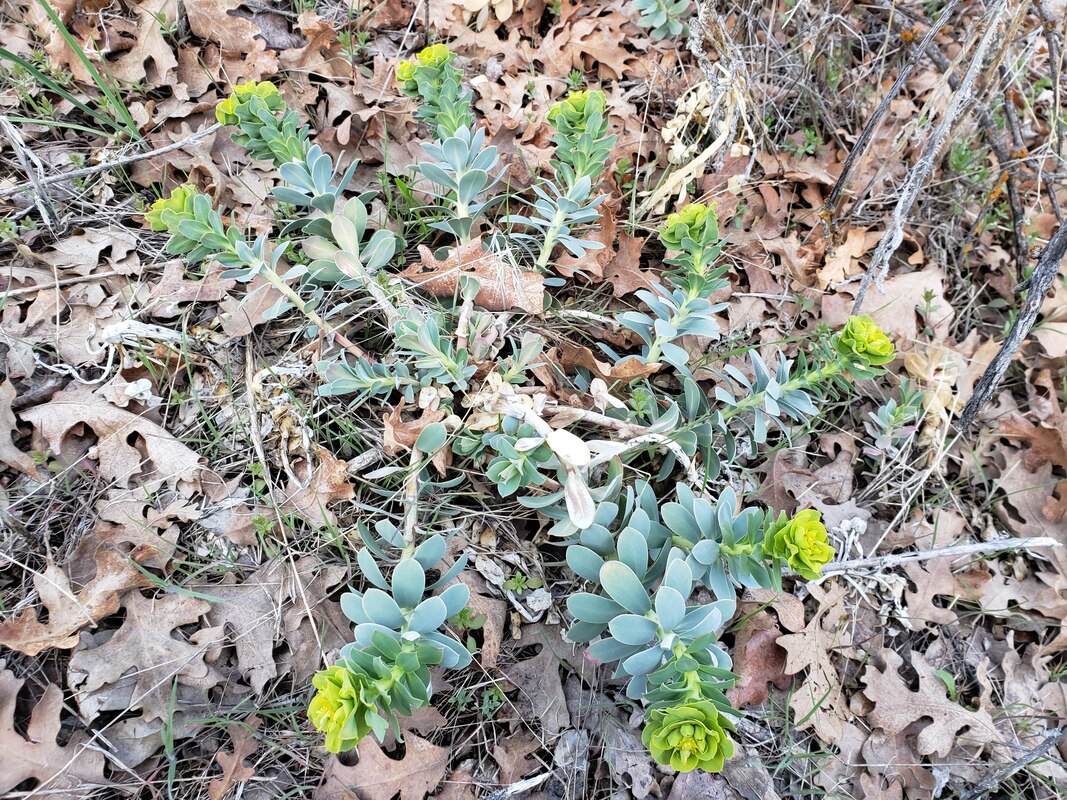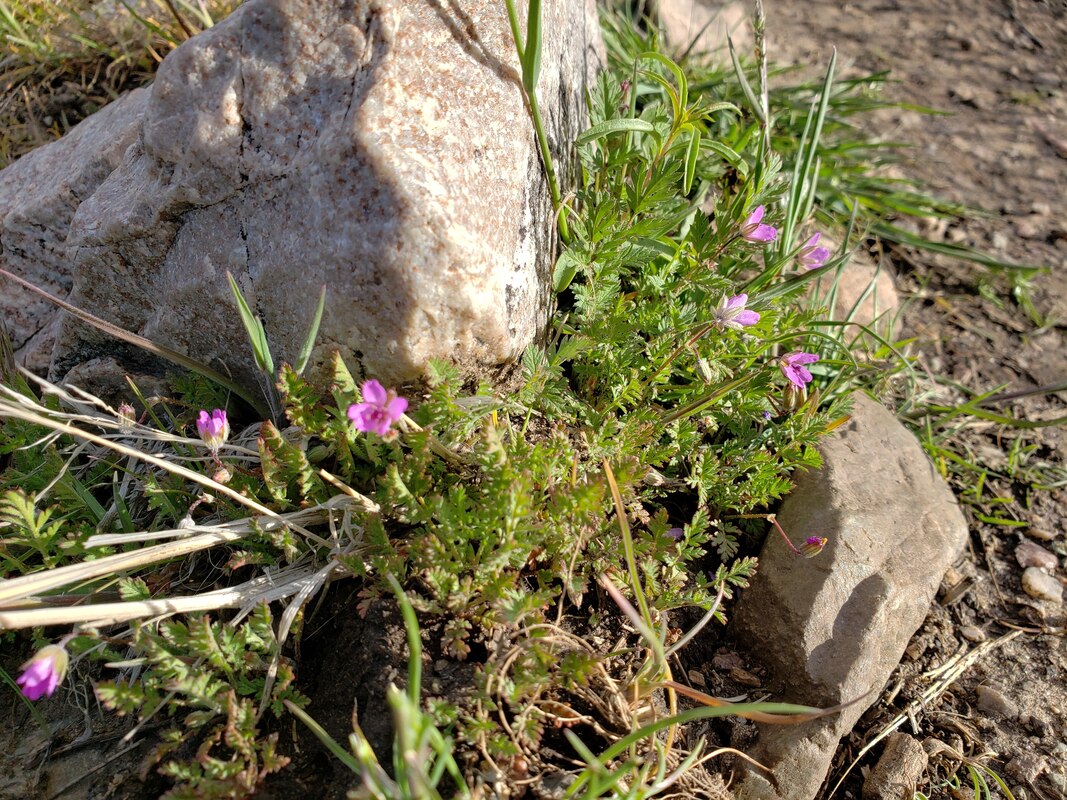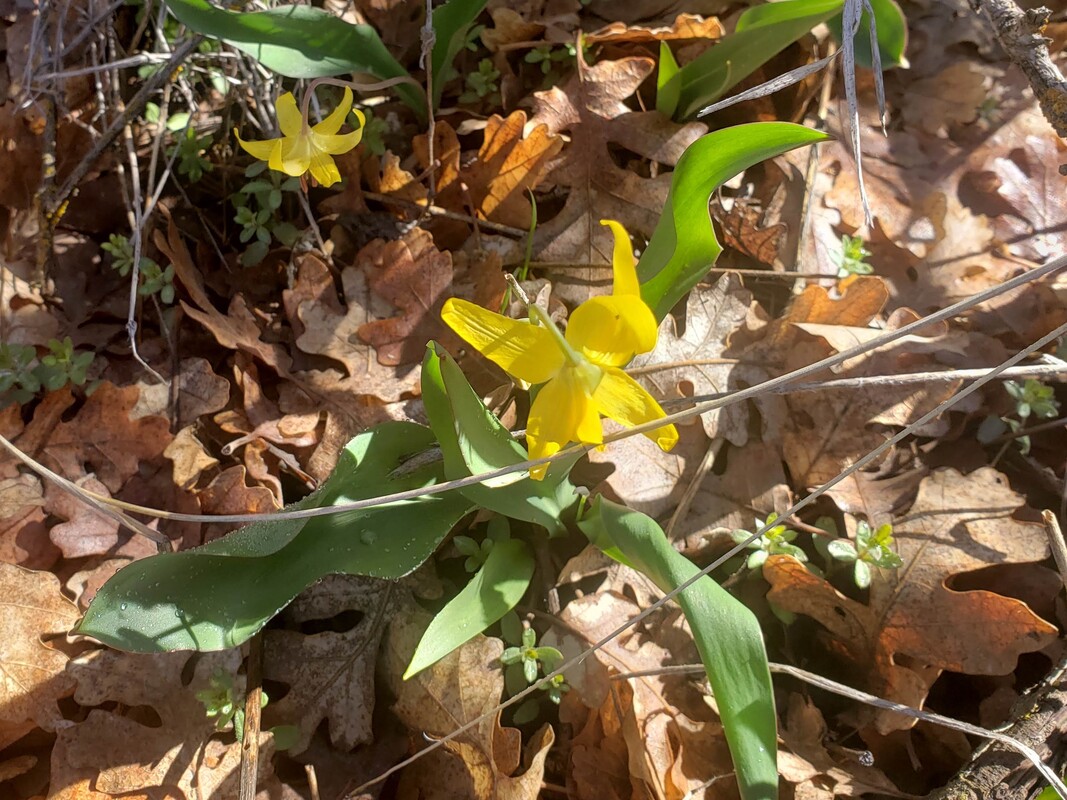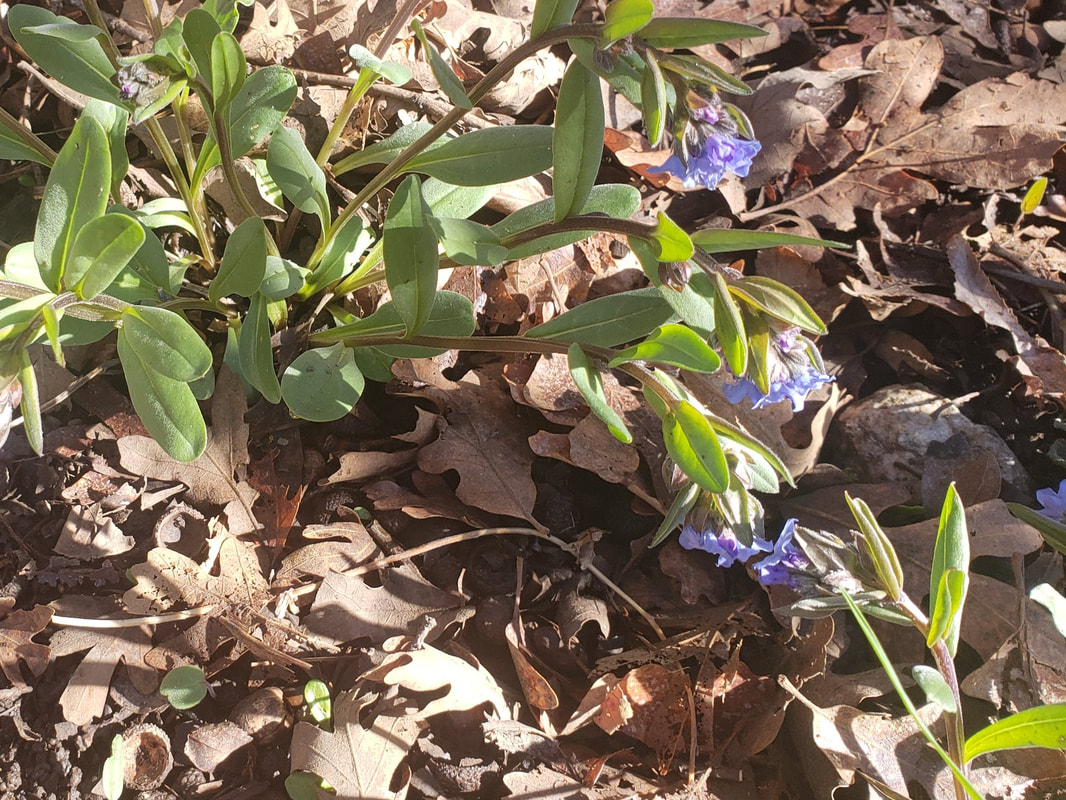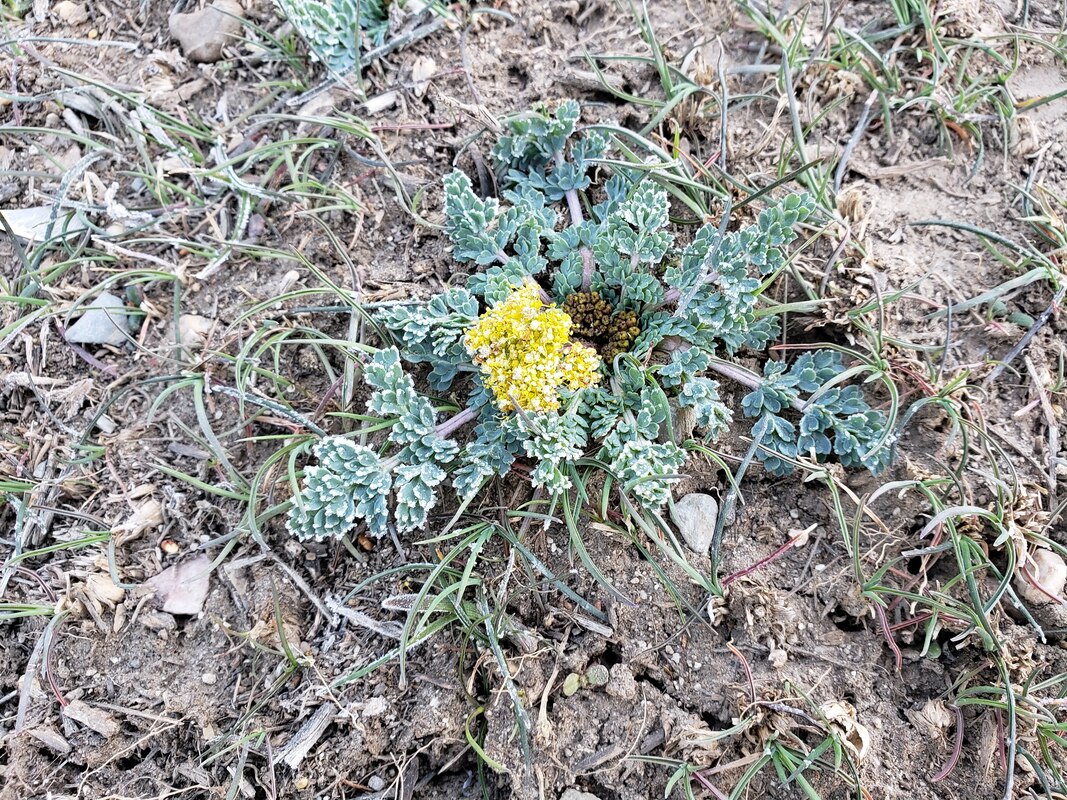The Amen of nature is always a flower.
- Oliver Wendell Holmes, Sr. -
- Oliver Wendell Holmes, Sr. -
Check this page on a regular basis to see what's new and in bloom in Lambert Park for 2021!
|
28 September 2021
Rabbit Brush is also known as gray rabbitbrush, or chamisa. This perennial shrub is a member of the Aster family along with sagebrush. Flowers bloom from August to October as other plants are fading, providing vivid color and a pollen source for insects late in the summer. If you travel to central and southern Utah many fields are ablaze with color! The shrubs reproduce via an abundance of small, wind-dispersed seeds and can also sprout from the base. Native Americans reportedly used Rabbit Brush as a yellow dye, to make a medicinal tea, and for chewing gum. The Russian Thistle is an invader brought to the United States about 1873 by Ukrainian immigrants to South Dakota. It was accidentally introduced as a contaminant in flax seeds and quickly spread throughout the west. Although it is generally not beneficial to livestock, it was credited for saving cattle during the Great Depression. It is the inspiration behind the great cowboy song, Tumbling Tumbleweeds, which you can hear by clicking this link! The Western Ragweed is flowering and will releases billions of pollen spores into the air. This is one of the major banes of 10 to 20 percent of the population that sufferers from allergies. This plant is native to North America, and we in turn have shared it with the rest of the world! It is now naturalized in parts of Europe, Asia, Australia, and South America. |
|
23 September 2021
There are still new surprises in Lambert Park! The Redroot Buckwheat is in bloom! This beautiful plant starts out as spindly sage-green stems that finally burst into flower, starting white, and then turning a soft pink! This unique late bloomer is native to Utah, Colorado, Arizona, Nevada and New Mexico. Its roots were used to treat poisoning and diarrhea by the Navajo. It is also is a food plant for the Spalding Dotted-Blue butterfly as well as the Desert Green or Comstock's Hairstreak butterfly. This Tamarisk Tree, could be the beginning of an invasion in Lambert Park if not removed! The Tamarisk comes from Europe or the eastern Mediterranean, and has adapted so well to our western landscape, that it has displaced native species. It is a fire hazard and consumes more water along creek beds than native species. |
|
30 August 2021
A beautiful bloom is the Showy Goldeneye! This colorful plant in the sunflower family will bloom for many weeks. It tends to grow in thick clusters and provides eye-popping color along roadsides and in Lambert Park, as well! The Common Mullein draws attention to itself with it's tall spike of yellow flowers. This invader from Europe and Asia has many medicinal purposes, including a tea made that helps with incontinence. It's large fuzzy leaves can also serve as nature's toilet paper for campers who are caught unprepared! The Common Sunflower originated in North American and was taken back to Europe by early explorers. In addition to it's colorful beauty, it was prized for its oil as well as its seeds! The Velvety Goldenrod is a bright splash of color found on the top of Spring trail, as well as "Dog" Trails and other areas. |
|
13 July 2021
It's Chicory time! The roadsides are lined with this beautiful blue bloom, and the park has a large number of chicory growing in it, as well! It is a European native plant that is welcome here, and is even used for forage for livestock. Alfalfa came from southwestern Asia around 1736. It is a popular feed for livestock as well as wildlife. It is very nutritious, having more protein per acre than most other crops! It also provides important coverage for nesting waterfowls and other birds! In early summer the prolific six inch circles of grass in Lambert Park don't show much promise, but the Rock Goldenrod is now starting to bloom, portending a another profusion of yellow color across the park! This North American native has the scientific name of Petradoria Pumila! Petra from 'rock' and doria from 'gold.' Hairy Golden Aster thrives in the foothills and mountains, as well as vacant lots, farmyards and along roadsides. It also thrives in Lambert Park! It needs little water and can bloom for three or four months! To add to its allure, it also has a marvelous spicy-sharp aroma! Curlycup Gumweed is a native plant that is easy to identify for the stickiness of the upper portion of the plant, as well as the curly bracts below the flower head. It has been used in traditional applications, such as treatment for poison ivy and bronchial asthsma. |
|
9 June 2021
In New Mexico and Colorado, Yarrow is known as plumajillo (Spanish for little feather). The leaves are soft and feather, with tiny leaves on them. The plant has been used medicinally to stanch bleeding which use can it an additional name: herbal militaris. Whatever it's name, this plant with showy white flowers is a real addition to our landscape in Lambert Park! Yellow Sweet Clover, although a Eurasian import, has found a place in our landscape. Livestock can tolerate it, and bees love it! Clover honey from nearby hives is a light colored, mild flavored honey purported to be rich in zinc, copper, magnesium, potassium, and manganese, as well as high levels of B vitamins, vitamin C, polyphenolic antioxidants, hydrogen peroxide, and calcium. It sounds like the perfect cure for whatever ails you! Blue flax, is a native to western North America, and adds a brilliant shade of blue to our meadows! When roasted, flax seeds have a pleasant nutty taste, and are very nutritious. However, the raw seeds contain cyanide which is destroyed during the cooking process. It is also used medicinally and has an oil similar to linseed oil! Showy Milkweed is just that--showy! It's blooms don't last long, but are beautifully star-shaped and eye-catching! It is a native plant with thick stems, which the Native Americans used in basketry and rope. It is toxic to humans and livestock, but not to Monarch butterflies, who especially love it's nectar and protection. The nectar makes the butterflies taste bad to other animals, and the plant provides a host for butterfly eggs and larva. Utah Thistle, a variation of New Mexican Thistle, is a beautiful thistle, but this native plant is considered to be non non-weedy! Like many thistles, it is very attractive to bees and other insects. The make a great spot to observe tiny creatures around us! Musk Thistle is one of the most beautiful noxious weeds in the state! It is also called Nodding Thistle for the flower head that tends to nod to one side. This Eurasian invader grows well in disturbed areas and can supplant native species. The Elderberry Tree seems out of sync with its blooming neighbors, flowering an entire month later than the other fruit trees in Lambert Park! The distinctive spreading white-yellow blooms appear almost flat on top! Its fruit can be made into wine, syrup, jams and pies, but some people enjoy dipping a bunch of the flowers (held by the stem) into some batter and deep fat frying them! As with so many of these fruits, it is best not to eat the seeds! Woods Rose is native to north America. It was named for the botanist, Joseph Woods, not for the forest. |
|
26 May 2021
Our state flower is in bloom, but won't last long. See the Sego Lilies along the southern part of Poppy Trail in Lambert Park or where the Crossfire and Corkscrew trails meet! It was chosen as the state flower not just for its beauty, but because of the bulb being used by indigenous people as well as pioneers as a food source. There is a lovely patch of Wild Hyacinth along Rodeo Up Trail. It is also called Largeflower Triplet Lily because of the petal arrangements--two sets of three petals, one inside the other! Bindweed, is not even remotely related to the morning glory, despite the fact that many of us know it by that name. It is a native of Europe, and grows vine-like over ground and vegetation, making it hard to eradicate. It's success has been the bane of many a gardener, trying to eradicate it from their yard! Western Waterleaf is striking, with it's dainty bottlebrush appearance. It can catch and hold water in its cavities, and can survive in a variety of habitats because of that ability. Western Hawksbeard, is a member of the sunflower family that is also native to the United States. It's leaves are slightly and toothed. and it's bright yellow rays are a splash of sunshine in the prairie! Linear Phacelia is another native of North America that thrives in forests, woodlands, open scrub and other habitats! It's hearty ability to grow in such a variety of habitats belies its fragile beauty! The flowers are still out on the Red-Twig Dogwood growing at the source of Grove Spring. Keep an eye out for small white berries beginning to form on it! While the berries can be somewhat palatable, they also induce vomiting when consumed in large quantities! There are so many kinds of peas in Lambert Park! Utah Sweetvetch is about a foot tall and very showy right now. Unlike many forms of vetch, this one is palatable to livestock and wild animals, forming an important part of the sage grouse habitat! |
|
23 May 2021
Yellow Salsify or Goatsbeard is the queen of the dandelion family, with it's green crown-like spikes around the bloom. It is often called goat's beard after it's beautiful large seed head, twice the size of the dandelion! You can make a lot of wishes on it when you blow it apart! Wild Onions right here in Lambert Park! The Twincrest Onion is one of the many varieties of western onions, all of which are edible, though some are extremely potent and unpalatable. In the early days of the West, Indians saved at least one exploration party from scurvy by alerting the ill explorers to the curative properties of the wild onion! The Twincrest Onion is a favorite treat for black bears, elk and prairie dogs! False Solomon's Seal is sometimes called Solomon's Plume. It is distinguished by tiny white flowers with gigantic leaves out of proportion to the blooms. Spotted Stickseed is also known as the Spotted Forget-Me-Not (another forget-me-not!). It is native to the northwestern part of the United States, but has been introduced elsewhere in the country. One of our rare orange flowers is in bloom--the Scarlet Globemallow, which in other regions tends to actually be red! The Blackfeet Indians applied a paste made from this plant to burns, scalds and external sores as a soothing agents. The Yellow Roses are in bloom alongside the Lambert Ruin! Another ornamental flourishing in the park, the yellow roses of Lambert Ruin may have been planted by the Lamberts themselves! The Common Poppies are starting to bloom at the Lambert Ruin! Despite it's name, there is nothing "common" about this flower! It's robust showiness is in stark contrast to the subtlety of the native flowers in the park. The poppy has been a symbol of remembrance of military veterans since the 1915 publishing of the poem describing the beautiful contrast of the poppies growing on the military battlefield in Flanders Fields. Count the petals on the flowers of the Tumble Mustard. If it has four, you might suspect its a mustard! There is also a similar-looking purple mustard in the park. In the winter the remains of the mustard turn into tumbleweeds! The Chokecherry Trees are plentiful along High Bench and Rodeo Down Trails. The fruit will become edible, but is very tart! The seeds are poisonous, so spit them out if you eat the berries. Birds love them, and so might you! The berries turn red, then black, and are sweetest later in the season! The Tapertip Onion are two of the many varieties of western onions, all of which are edible, though some are extremely potent and unpalatable (the other being the Twincrest Onion). Houndstongue is an accidental import from Europe that is considered an invasive weed in Utah. Despite its traditional use to cure just about everything from madness to baldness, it has fallen out of favor, perhaps due to inconclusive medicinal use of any kind. In addition, it forms a bur-like fruit that is really hard to get out of your dog's fur in should they run through a patch of it in the fall! The Spreading Fleabane is another plant that was used medicinally by Native Americans. The Navajo used it to aid in childbirth, as lotion, for eyewash, and also snakebite and headache! If you walk at 7am in the morning you will think it is a closed purple flower (as shown). But, by 9am it is wide open and white with a yellow center! It is exciting to find a Tufted Evening Primrose in bloom, as each blossom only lasts one day! The white flower turns pink as it dies. This pretty white flower with four heart-shaped leaves is supposed to only blossom in late afternoon or evening, as it is pollinated by night-flying insects, but we found this one in the morning. The Black Hawthorn is plentiful along Rodeo Down, Spring, and the west side of High Bench trails. Beware of the "thorn." It is 1 1/2 inches long and very sharp! The berries (called haws) are not ripe yet, but when ripe they are edible! The seeds contain cyanide (like apple seeds), so it is best to spit them out! Dalmatian Toadflax, a flower introduced from Europe as an ornamental has become an aggressive invasive weed in the west. It comes from the Dalmatia region of Croatia (just like the dogs)! It is all over Lambert Park, and looks so pretty when it is in bloom! |
|
6 May 2021
Meadow Salsify and its related flowers sometimes are called Jack-Go-To-Bed-At-Noon because they follow the sun in the morning and close up their flowers in the afternoon. They are a native of Europe but can now be found over much of the United States. There is a stand of St. Lucie Cherries growing just west (downhill) of the south water tower in Lambert Park. They are also known as Rock or Mahleb Cherries. They are ornamental natives from Europe, Asia and Africa that are cultivated for a spice obtained from the cherry pits. Birds especially love the fruit and are big seed dispersers! The Desert Indian Paintbrush is a deceptive plant. It's leafy red bracts are not the flowers, but rather they surround a greenish white flower at the very tip. They are very pretty parasites! The roots drill into the roots of surrounding plants, stealing their resources! Corn Gromwell, a soft and delicate little white flower has nothing to do with corn, but has recently graduated from invasive weed to a plant with healthy possibilities. Farmers in its native Scotland are growing it for its high concentration of omega 3-fatty acids! It does better than fish oils in this regard! A real boon for vegans around the world! The Golden Currant Bush is in it's glory! It's bright yellow flowers will later give way to golden, then orange, then red, very tasty berries! Its scalloped leaves change to deep maroon in the fall. The Common Pear is a small to medium sized tree with a broad crown, a straight trunk and arching branches. Its leaves are oval with a pointed tip and fine teeth along their edges. Its flowers have five white petals and purple anthers. They are borne in clusters that open with the leaves in early spring. This pretty white Ballhead Waterleaf was found on Rodeo up. There are two kinds of Waterleaf in the park. They can be distinguished by where the bloom occurs. The Ballhead Waterleaf blossom occurs below the leaves, while the Western Waterleaf blossoms above the basal leaves. Whitetop is classified as an invasive weed in Utah. It came over from Asia and easily crowded out beneficial, native species that provide habitat for animals. It grows especially well under cheat grass in burn areas! Danger, Danger! The native Death Camas is in bloom! Don't even think about eating a plant with the word 'death' in its name! Every part of the plant, from the bulbs to the stems, to the leaves and flowers is poisonous to humans as well as livestock! Just look at it and enjoy! Lambstongue Groundsel or Ragwort was used by settlers and ranchers to determine range “readiness.” When it was in flower, the range was believed to be sufficiently developed for grazing to begin. The Bush Pea is a beautiful purple flower, but don't let your livestock eat it! Many members of the Lathyrus family are toxic to animals, especially horses! Long-leaf Phlox is native to central and western America. It does well in dry, sandy soils. It's hard to classify by color, as it varies from white to pink to purple. The lemonade trees are starting to bud out! Aromatic Sumac is the most common shrub in Lambert Park. The seeds have a lemony flavor that some hikers like to add to their water bottles. The seeds will turn deep red in summer, but for now, enjoy them in their yellow finery. |
|
April 26, 2021
This week more new flowers showed up. Curveseed Butterwort is an invader from Eurasia. Like other members of the buttercup family, it is poisonous. In addition to a pretty star-shaped flower, it grows clusters of hard, spine fruits (burs). Arrowleaf Balsamroot is a hearty plant that was used by native American tribes for food and medicine. It is bitter and pine-tasting. Today we can enjoy it chiefly for it's vibrant spring colors! Oregon Grape originated in the northwest and is the state flower of Oregon. We're glad it made all the way to Utah, as it's waxy holly-shaped leaves, and bright yellow flowers add a lushness to our landscape. Find it on Spring and Rodeo Up paths in Lambert Park. We'd rather not celebrate the blooming of the dreaded Myrtle Spurge, as it is one plant we would like to completely eradicate from Lambert Park! This succulent, brought over as an ornamental plant from Southeastern Europe and Asia Minor, is extremely drought resistant and thrives in the west. It pushes out native plants and its milky sap is a dangerous irritant to human skin and eyes! Purge it from your yards, but use gloves and plastic bags! Utah Milkvetch, a native Utah plant, is also found in portions of Idaho and Nevada. It is also called Ladyslipper and Locoweed, the later for its propensity to be harmful to livestock. Some species contain significant amounts of alkaloids and/or toxic metals like selenium. Don't eat it! The Redstem Filaree, also called Stork's Bill is originally from the Mediterranean, but was already widely distributed in the west when it was observed by John C. Fremont in 1844. Although it can be an aggressive invader of open areas, it can also serve as good spring forage for cattle, sheep, desert tortoise, and other wildlife. |
|
April 19, 2021
It's been a somewhat cold Spring so far and the flowers are taking their time getting here. But we have two new arrivals. The first is the Glacier Lily, which is also known as the Yellow Avalanche Lily, snow lily, and trout lily. One of the reasons it is called glacier lily is because it often can be seen growing at the edge of a retreating snow bank. As the snow melts in the spring the ground becomes very moist and this flower pops up and starts growing. Another new arrival is the Shortstyle Bluebell. It is found in open to lightly wooded areas and dry meadows in elevations up to 3000 meters in the mountains of the interior West in early springtime. It is common in the Wasatch and Uinta mountains of Utah. It can also be found in the southeast portions of Idaho, and scattered along southern Wyoming and western Colorado from April to June. |
